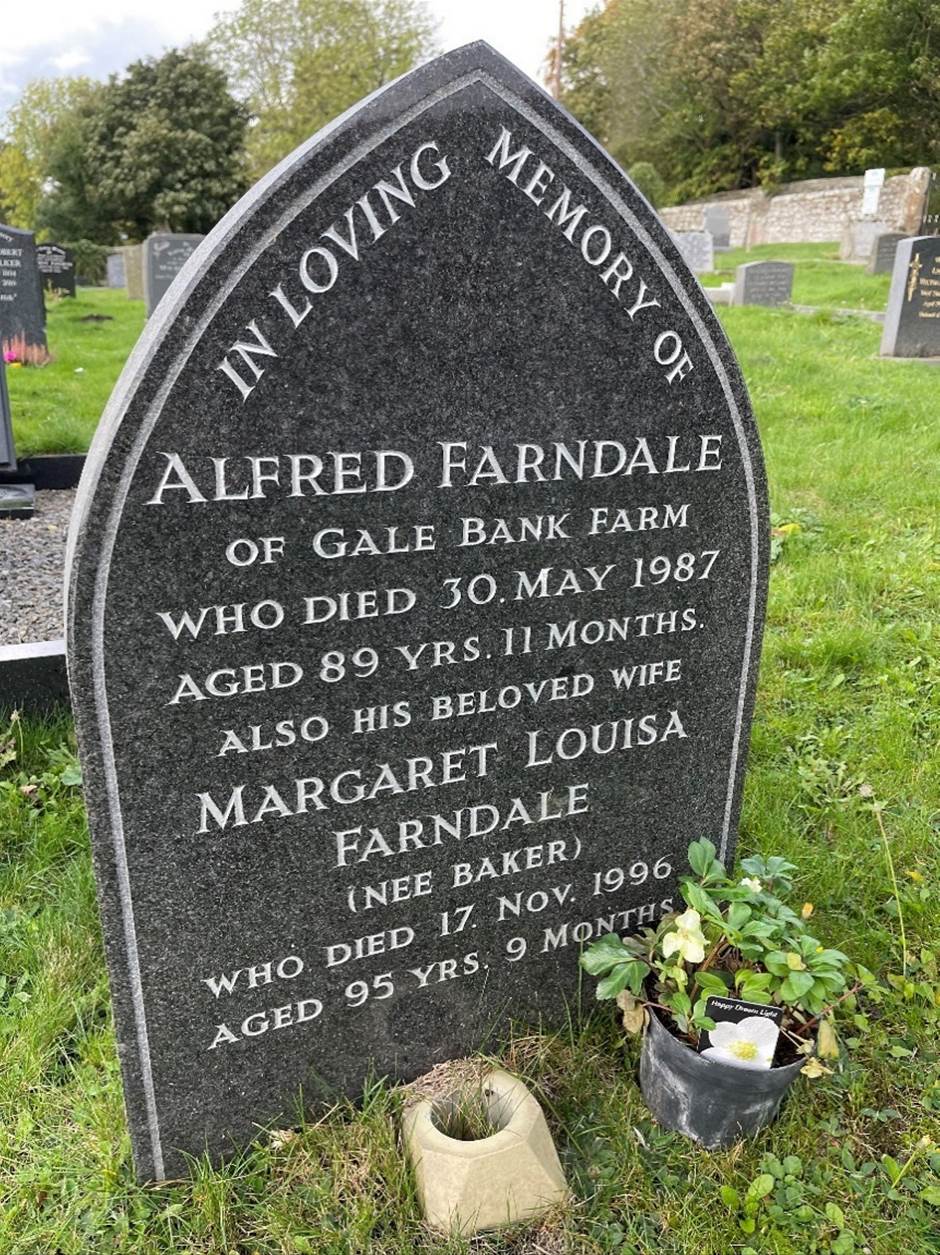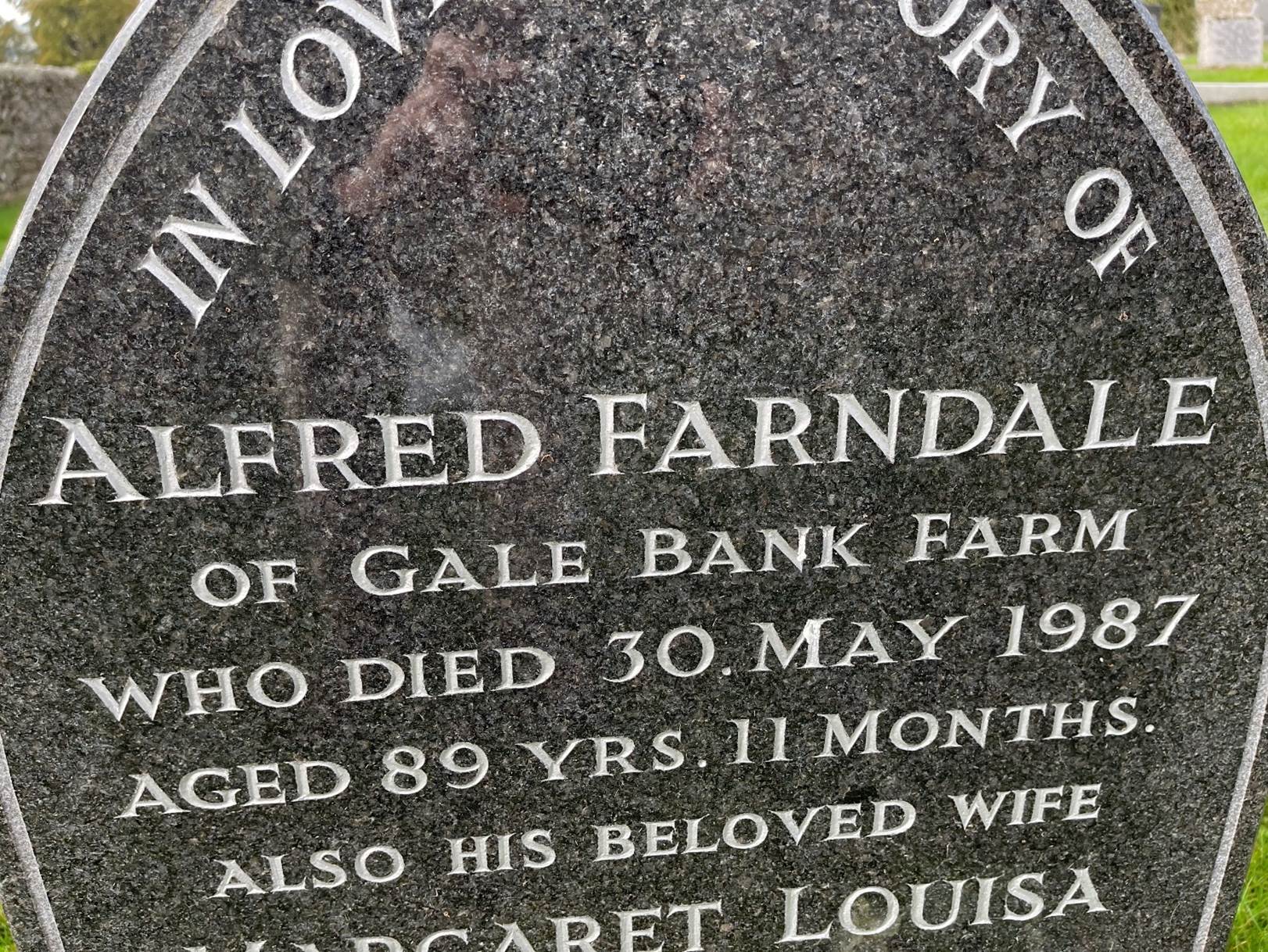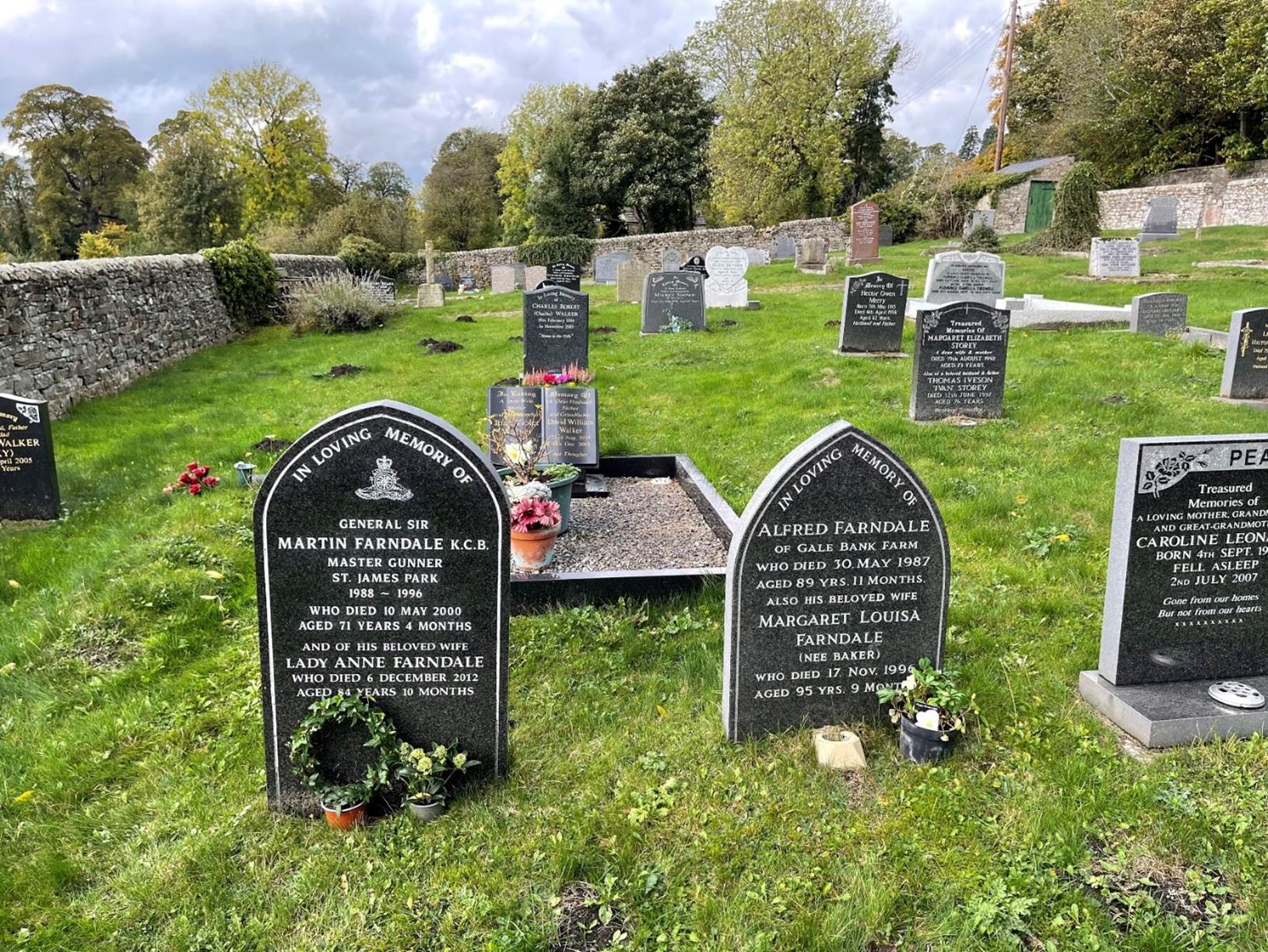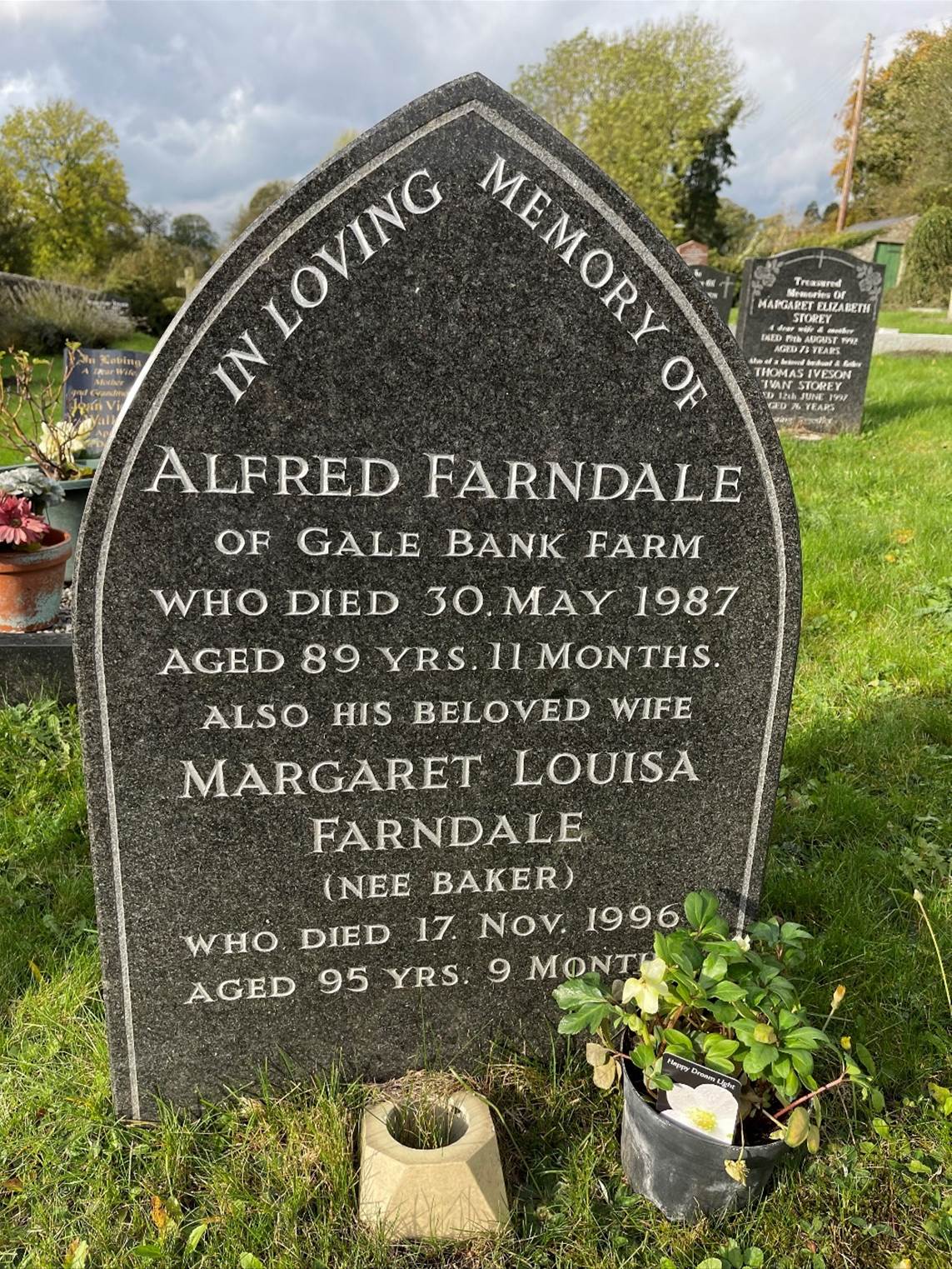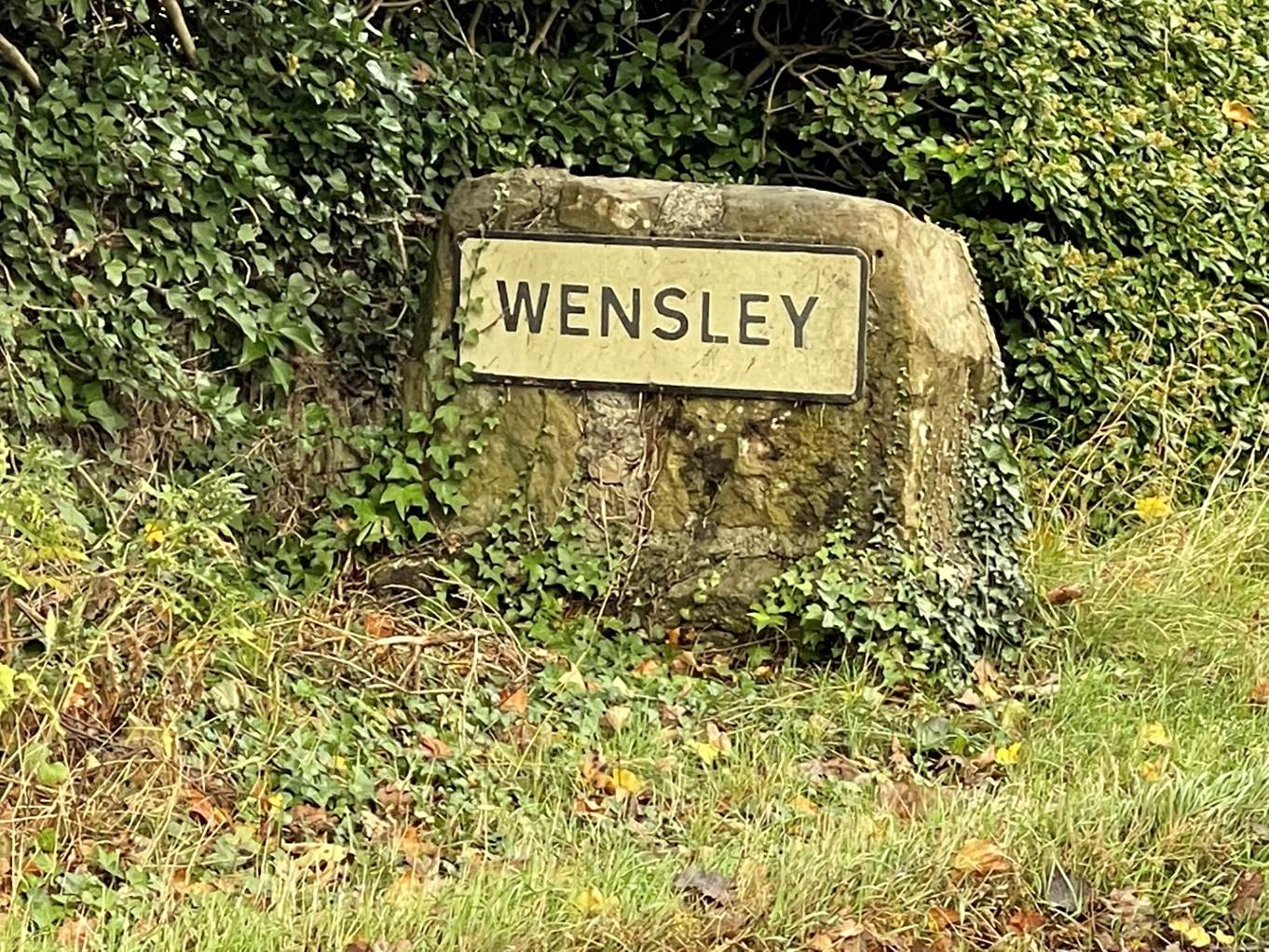|
Alfred Farndale led a
long, varied and active life as a farmer, soldier and pioneer of Western
Canada. A Soldier in WW1 and farmer in Wensleydale |
Alfred Farndale
FAR00683
|
Dates are in red.
Hyperlinks to other pages are in dark blue.
Headlines of Alfred’s life are in brown.
References and citations are in turquoise.
Context and local history are in purple.
Geographical
context is in green.
Tidkinhow
1897
Alfred Farndale,
the son of Martin and Catherine Jane Farndale, formerly Lindsay, (FAR00364) was
born on 5 July 1897 at Tidkinhow Farm, Stranghow, Skelton (BR,
GRO Vol 9d page 487, and family knowledge). He was the
youngest of twelve children.

1901
In the 1901 census he was registered at 105
Stanhope Street, Westgate, Newcastle. Alfred Farndale aged 3 is shown with Kate
Farndale (born 1955) and the Heslop family from Alwick.
He is shown as their nephew. So presumably he was with his mother, Catherine
(Kate) and perhaps her sister and they were on a visit at the time of the
census.
1902

Alfred in 1902
Early years
In a talk
between Alfred Farndale and his son, Martin
on 29 July 1982, Alfred recalled, "I remember going to school
at Charltons
near Tidkinhow. We then went to Standard 1
at Boosbeck. We stayed there until we were
14. It was a two mile walk each day. The headmaster was Mr Ranson. I remember
Jim, my elder brother catching me fishing and playing truant. He just said
"Get in" (he was in a pony and trap) and he took me to a days marketing at Stokesley. I remember the second masters
name was Ackroyd. I got a fork through my leg and he sucked it out. We were
always inspected as we arrived at school. We had to walk past the Bainbridge
place and people used to say that he had more sheep on the moor
than he was allowed. I remember William looking after me at mother's funeral. I
was crying and very upset.”
His mother, Catherine Jane Farndale, died in 1911.
He
continued to go to a local school and was working at home when the war broke
out in 1914.
1910


The boys of Tidkinhow in about 1910 -
John, James, Alfred, William, George and inset Martin
1911
The 1911 Census for Tidkinhow Farm,
Boosbeck, Stanghow listed Martin Farndale, 65, farmer, head, born Charlton;
John Farndale, 33; Catherine Jane Farndale (Alfred’s sister, not his mother),
26; William Farndale, 20, butcher; Grace Alice Farndale, 17 and Alfred
Farndale, 13, born 1898.

France
and Mesopotamia
Military Service from 1915 to
1920
Alfred joined the East Yorkshire Regiment in 1916,
but then volunteered for the Machine-Gun Corps and served on the front line
with 239th Company at Ypres in France until mid 1917 when he went to
Mesopothamia and served in action there until the end of the war.
In a talk
between Alfred Farndale and his son, Martin
on 29 July 1982, Alfred recalled
"The war came in 1914 and I was just 17. I wanted to join up so
I ran away and joined up at the local recruiting office at Northallerton, somewhere in South Parade
I think. I joined the West Yorks but my father found out and said I was under
age, which I was. The CO wanted me to stay on the band, but father wouldn't
hear of it and I came out. I remember being very proud of my first leave in
uniform. Then one day they called for volunteers for the Machine-Gun Corps and
I stepped forward. We went to Belton Park, near Grantham for training. I joined
239th Company MGC and we were attached to the Middlesex Regiment. In 1917 we
sailed for Calais and went to "Dickiebush"
Camp. We were first in action at Westbrook and Polygon Wood. I remember an
incident on the Menin Road galloping up with two limbers of ammunition towards
the gun positions at Hooge. I was a Private but I was giving a lift to Quarter
Master Sergeant Zaccarelli. The Germans started to shell us. They could clearly
see us. I had one horse killed and I managed to cut him free and I then rode
the other. Zaccarelli was killed; it was quite a party when I reported it. My
Captain asked if there were any witnesses but there were none, otherwise I
might have got something. I remember an officer coming up to me when we were
under bombardment at Ypres and saying "How would you like to be in
Saltburn now, Farndale?" We saw some action at Zonnebeke,
Ploegstraat and Arras. Then suddenly we were ordered
to Marseilles and got on a troopship for Basra in Mesoptamia.
After about 14 days we were in the Suez Canal and then the Red Sea. We landed
at Basra and marched to Kut-el-Amara
as part of a force under General Maud to relieve Townsend. About the middle of
1918 the Turks surrendered. We hung around for quite a while. I cut my thumb on
a bully beef tin and it got poisoned. I was in hospital in Kut
when 239th Company left for England. I eventually got to Mosul where I thought
my unit was and met my platoon commander Lieutenant Pearson. He asked me where
I had been and put me in charge of the officers mess. We had some Punjabi
officers at the time and they used to knock me up to try to get whiskey! Later
in 1918 we were ordered to Bombay. I remember I had to take my stripes down on
the troopship. We were sent up to the Afghan frontier for a while and we had
quite a lot of trouble in the local bazaars.
Eventually in early 1919 I think, we got a
troopship to England. We landed at Southampton. I remember we were told that we
could keep our greatcoats or take £1 when we were demobbed on Salisbury Plain.
I took the £1! I remember arriving at Middlesborough
station very late at night and sleeping on the platform. I got the first train
next day to Guisborough and actually arrived at Tidkinhow before they were up! This would be
in 1919. I know that I was clear of the army by the start of 1920. I wish I had
stayed in. I really did like the army life. But I had to come out.”
He served in France, Iraq and India.


The military records show that Alfred was a Private, Machine
Gun Corps, 249th Machine Gun Company. 83795 Private Alfred Farndale,
Machine Gun Corps, enlisted into 88th Training Reserve Battalion at
Northallerton 13 December 1915.


Alfred East Yorks 1915
He was relegated to the Army Reserve
(under age) 14 December 1915. He re-enlisted on 5 December 1916. His
Attestation on 13 December 1915 showed his address at Waterfall Farm,
Guisborough and he was a farm labourer. His age was 18 years and 5 months. He went
to the Army Reserve (88th Training Reserve Battalion) on 14 December
1915 and was mobilised on 6 December 1916. He was posted on 9 December 1916.
Transferred to the Machine-Gun Corps 30 January 1917.

Machine Gun Corps at Belton Park,
Grantham in 1917
A MGC
Transferral Oder showed him proceeding to the British Expeditionary Force (ie in France) on 12 July 1917. He embarked at Southampton
on 13 July and disembarked at Le Havre on 17 July 1917. Posted to 239th Company
MGC BEF 13 July 1917. His Medical
History Record showed he was 5 ft 6 ¼ inches height and 133 lbs.

Ypres, France, 1917 (Alfred centre,
rear)
Service Overseas BEF from 13 July to 13
October 1917 (3 months)
Service overseas Iraq and India from 14
October 1917 to 9 January 1920 (2 years and 3 months). His later
service was recorded with 239 Company in Mesopotamia. See also here.
Posted to 18th Indian Divisional
Battalion 10 January 1919. Posted to 17th Indian Divisional Battalion 10
January 1920.


A corporal
A sergeant
Alfred in Mesopotamia 1917 to 1918
There is a record
of an accidental injury and in a separate statement, he wrote “While
opening a tin of canned beef on 2 February 1919 at Baiju Station with Jack Knife,
the knife slipped and cut my right thumb. A Farndale.”
Service with the colours from 6 December
1916 to 18 March 1920 (3 years and 3 months)
Transferred to Class Z Army Reserve on demobilisation on 19 March 1920.
Discharged 31 March 1920 on General Demobilisation. His Identify
Certificate was issued on his dispersal on 20 February 1920. His address
for pay was Tidkinhow, Boosbeck. His
(most recent) theatre of War was recorded at Mesopotamia. The place for
rejoining in case of emergency was Clipstone. He was
granted 28 days furlough from the stamp date. The standard form
completed by all soldiers regarding any disability, showed that he had none
at the time of his discharge.
He was awarded the British War Medal,
issued 17 March 1922 and the Victory Medal, issued 17 March 1922.
The
Northern Echo, 8 November 2011 narrated:
Heroics in the face of hell
Private Alfred Farndale was an unsung
hero of the First World War. As Remembrance Day approaches, Ruth Campbell hears
how this brave North Yorkshire lad went on to see his son rise to the rank of
general.
The moving dedication at the beginning
of Nigel Farndale’s novel hints at the hell his grandfather, a young farm boy
from North Yorkshire, experienced in the muddy, blood-drenched trenches of the
First World War: “For my grandfather, Private Alfred Farndale, who died in the
mud of Passchendaele, and again seventy years later in his bed.”
In Farndale’s view, every man died in that
battle, even those who survived. For the dark, life-sapping shadow that
descended on them all snuffed out a vital spark.
The battle raged for 100 days. More than
half a million Allied troops and a quarter of a million German were killed. The
dead would be buried under a deluge of soil only to be disinterred by the next
shell, and reburied by the next.
In his novel, The Blasphemer, partly
inspired by young Alfred’s traumatic experiences, Farndale vividly brings to
life the horrors young men endured. As a boy, he had listened to his
grandfather’s tales of war as they worked together on the family farm near
Leyburn.
But the silences were just as memorable:
“He was an affable man but prone to dark mood swings. There were long periods,
maybe three weeks at a time, when he wouldn’t talk. I had little doubt what lay
behind it, having grown up listening to his stories of life in the trenches.
It deeply affected him,” he says.
Alfred’s eldest son, Farndale’s uncle,
went on to join the Army against his wishes and rose to the rank of general.
The fact that a former private’s son was able to go on to claim the title
General Sir Martin Farndale, Commander-In- Chief of the British Army of the
Rhine is perhaps partly due to the social upheaval that followed the Great War.
ALFRED’S beginnings were much more
humble. Born in Knaresborough, he was the youngest of 12 children and in a
reserved occupation looking after the stock on his parents’ farm near
Guisborough when, against their wishes, he lied about his age at 17, signing up
at the local Army recruitment office in Northallerton.
Despite being sent home because he was
too young, he volunteered again as soon as he was able. Alfred knew something
of the realities of life on the Front Line and would have been very aware of
what he was letting himself in for.
“My grandfather had two older brothers
fighting in the trenches and one had been shot in the elbow. His cousin George
had been killed at Ypres in May 1917. There were widespread reports of the
20,000 men killed and 40,000 injured on the first day of the Somme. It was
quite a frightening prospect.”
Alfred certainly rose to the challenge.
He was, undoubtedly, a hero, and an unsung one at that. One of the stories he
told his family, about a daring dash under fire to deliver much needed
ammunition to the Front Line, revealed an act of bravery that had gone
unnoticed in the chaos of battle.
“My grandfather was haunted by this
incident,” says Farndale who, in 2007 visited the battlefield with his father
to mark the 90th anniversary of Passchendaele.
“It was a moving experience. When we
came to the notorious spot known as Hellfire Corner, we remembered the story he
told us. He and Quartermaster Sergeant Zaccarelli had been galloping up to the
Front with an ammunition limber when the Germans started to shell them.
Zaccarelli was killed, along with a horse.
My grandfather managed to cut the dead
horse free, drag Zaccarelli’s body into a ditch and carry on up to the Front on
one horse with his delivery of ammunition.
“It amounted to family legend because
there were no witnesses or dates, just this memorable surname. We came across a
small British war cemetery and there was the surname, only spelt slightly
differently. Company Quartermaster Sergeant John Zottarelli
died on August 28, 1917, a month into the battle of Passchendaele.
He was 27.
“Until that moment we didn’t really believe
it had happened. He was a real person after all, not a myth, and when we stood
before his grave my father and I felt the hairs on the backs of our necks rise.
“It was so arbitrary; this man happened
to die and my grandfather happened to live. This meant my father had been given
life, and so too had I.”
For Farndale, visiting the site of the
battlefield brought much of what his grandfather had told him to life. He
recalls Alfred explaining the complex trench systems and the nicknames they
used to describe them. As he stood there, Farndale could even sense the smells
his grandfather and comrades had to endure… “an acrid combination of cordite,
mustard, chlorine, sweat and putrefying horseflesh,” he says.
“He would tell me about the noise, which
was so loud, so deafening, it gave men mild concussion.
They couldn’t even remember their names,
they weren’t able to count to three. During one particularly heavy bombardment,
his first commanding officer from the Yorkshire Regiment recognised him.
“I bet you’d rather be in Saltburn now,
Farndale’,” he said.
Alfred talked a lot about the mud. “The
drainage system on this reclaimed marshland had been destroyed by shelling. It
was a landscape of mud, one big bog. As well as constantly dodging bullets,
soldiers who slipped off the slippery duckboard walkways, just 18 inches wide,
were drowned in an orange sea of bubbling, gas-poisoned mud. It was a death
trap.
“In winter on the farm, when we got
stuck in deep mud, he would say ‘This was like the dry bit in Passchendaele,
dry enough to sleep on’. We talked a lot. We would go round the stock together,
singing World War One songs. I don’t think I quite got the brutality of it when
I was young, but the War seemed very immediate to me.”
Inspired by his grandfather’s story,
Farndale, 47, did more in-depth research into the experiences of young men in
the First World War. In The Blasphemer, which takes place partly in the present
day and partly in the First World War, he explores what happens when our
courage is put to the test.
“My generation didn’t have the
experience of war to test our courage. That is what I wanted to explore,” he
says.
He read letters and diaries written by
troops in the trenches, as well as personal accounts written after the war.
“Many of them left school at 14, but they wrote such vivid descriptions, in
such beautiful handwriting. The letters, written by 17 and 18- year-olds, were
very humbling. When the last of the veterans died, our remaining link with that
war was broken. All we have now is empathy.”
FARNDALE, who was born in Ripon and
studied at Durham University, named his 13-yearold son after his grandfather,
who enjoyed a lucky break after four months fighting in Passchedaele.
“He was among those British troops sent
to India. He ended up in Iraq and Basra for a short time. That saved his life,”
says Farndale.
When he returned to England, aged 22, Alfred
was offered the choice of taking £1 or keeping his greatcoat. He took the
pound. Other than that, he had nothing. With little work around, he farmed for
a while in Canada, before returning to Yorkshire.
“Things had changed. There wasn’t the
same deference,” says Farndale. “He was working in a field once when a local
aristocrat, who had managed to avoid fighting in the war, came along and told
him to open the gate. He told him to ‘open it yourself’.”
Alfred and his wife Peggy went on to
have four children and he died in 1987, just a few weeks short of his 90th
birthday.
“As I said in my dedication, he did
survive Passchendaele. But he died then as well,” says Farndale.
Tidkinhow
and Tancred Grange
1919 to 1928
In a talk
between Alfred Farndale and his son, Martin
on 29 July 1982, Alfred later recalled: I then went to Tancred Grange
to help my eldest sister Lynn whose husband had died in 1918. I spent my time
between Tancred and Tidkinhow till I
married your mother on 16 March 1928 at Bedale
Parish Church. Martin was over from Canada and he was best man. It was just
after my father died in January 1928. My eldest brother, John took over Tidkinhow. Peggy and I had already decided
to join the 'Canadians' [his brothers Jim, Martin and George and his sister
Kate] in Alberta. We went
to Huxley and rented a section of the CPR
and you three children were born. However we had bad luck with crops and the
slump and we had to go back to England in 1935.


Alfred about 1920
1921
In the 1921 Census for Tidkinhow, Martin
Farndale, 75, a widower, was farming, employed on his own account, and living
at home; John Farndale, his son, 43, single; Dorothy Farndale, his daughter,
25, single; Alfred Farndale, 23, single, his son, farming; and William
Barker, whose father had died, 14 years old, full time at school
1926
A certain Peggy Baker (BAK00002)
was teaching at Malvern School for Girls and she became friendly with Grace
Farndale (FAR00659),
Alfred’s sister, who was a matron. We know that Peggy did not like the
Headmistress at Malvern. Grace and Peggy got so fed up that they decided to go
to Yorkshire and start a chicken farm near to where Grace’s elder sister, Lynn
(nee Farndale) Barker (FAR00564) lived,
at Scorton, near Richmond. After moving to Yorkshire, Peggy met Grace’s
younger brother Alfred Farndale.



Margaret Louise Baker
(Peggy) in about 1925
The cottages at Scorton where Grace Farndale and Margaret Baker (later
married Alfred) had a poultry farm in about 1926





1927
Peggy
Baker became engaged to Alfred Farndale in 1927.


Alfred at Scorton
1927
Alfred at Tidkinhow in 1927
1928
Alfred Farndale married Margaret Louise Baker (of
Audlem, Cheshire) at Bedale Parish
Church on 16 March 1928. Alfred Farndale, bachelor, farmer aged 29 son of Martin
Farndale (deceased), married Margaret Louise Baker (BAK00002),
spinster of Leeming Bar daughter of Arthur Baker JP (deceased) at Bedale Parish
Church, on 16 Mar 1928 (BMD).




Alfred and Peggy’s
wedding
Bedale Church in December 1986
For Margaret (“Peggy”) Baker’s ancestry see the Baker Family Tree.
Alberta, Canada
Immediately after the wedding, they both went to
break open Prairie in Canada, where three of his elder brothers and two sisters were
doing the same thing.








The voyage to Canada


Alfred
Farndale built a house for his family in Huxley in 1928.
Alfred’s son Martin later recalled: Alfred
rented a section and a half near Huxley some 10 miles north of Trochu and built
a house there. The farm was almost entirely devoted to wheat but with some
cattle. I grew up at the farm and my first memories are of playing on the
prairie and around the slews (a kind of duck pond) near the farm. I remember
all the horses used for farm work, the box waggons with racks, threshing in the
fields and the hot summers. The winters were cold - well below zero, and I
remember the horse drawn sleighs and the bright sun on the snow. I remember the
village of Huxley, the annual sports day, the Legion parade and buying sweets
at Miss Hibbs’ store. I remember visits to the neighbours, the Hoggs, the
Saggers, the Morris’, the Wagstaffs, the Millers and I remember the postman, Mr
Hibbs whistling in his buggy as he came up the road to what is still today
called Farndale’s corner. But above all I remember the family. Uncle Martin and
Aunt Ruth lived near Trochu and he spoiled me a lot. Uncle George was a
bachelor, remote and living alone near Three Hills. Aunt Kate was strict and
austere, but kind and she lived between Trochu and Three Hills with her husband
Bill Kinsey and their children George, Alfred and Dorothy. I remember evening parties
and sitting waiting while the grown ups played bridge. I remember being well
looked after by our nannie, Gladys Grist who later married Aubrey, the son of
our nearest neighbour, Ralph Hogg.



Alfred building the
Farndale House on arrival in Alberta The porch of the Farndale
House
The House that Alfred Built



Alfred Farndale’s
House, Huxley in the 1970s (it no longer stands) Martin
Farndale in front of Alfred Farndale’s house in July 1973



George Kinsey and
Aubrey Hogg outside the Farndale house at Huxley in July 1973 The Farndale House, Huxley taken from
Hoggs’ Place in July 1973 The lilac hedge
and the grain bins
Family
Alfred and Peggy had
four children:
·
Martin Baker Farndale, born 6 Jan 1929 Trochu, Canada (FAR00911).
·
Marianne (“Anne”) Catherine Farndale, born 30 Oct 1930, Trochu Canada (FAR00915).
·
Alfred Geoffrey (“Geoff”) Farndale, born 10 Apr 1932, Elnora
Canada, (FAR00922).
·
Margaret (“Margot”) Lindsey Farndale, born 8 Oct 1937
Thornton-le-Moor, (FAR00952).
Huxley,
Alberta, 1928 to 1935
By the time the youngest brother, Alfred, and his wife
Margaret (“Peggy”) plus younger sister Grace, arrived in Alberta in 1928, the
family was well known in the District. These two members of the Farndale family
settled in the Huxley district. They lived
first with Alfred's elder brother, Martin, near Trochu while Alfred built their
house on Section 27, opposite Ralph Hogg's hill, and was two stories, with
white walls and a black roof, which stood out for miles around. The chimney was
the only part built of brick, and was made by Frank Holmes. It still stood for
many years into the 1990s, but was uninhabited from 1935. They built a wind
pump and several barns and later Alfred took another quarter section just east
of Huxley on the Wickiser Place. In 1929, their eldest son, Martin was born to
be followed in 1930 by Marianne (Anne) and in 1932, by Geoffrey. In 1930 Gladys
Grist from Trochu came to help look after
the children. She was later to marry Aubrey, son of Ralph Hogg who was Alfred's
nearest neighbour. Her son Philip later lived at their house and farmed most of
the Farndale farm.
Alfred had fought with the British army in World War I and completed
a unique team of three brothers who had fought with the Canadian, British and
American Armies in that terrible war. He was a member of the British Legion and
attended many an armistice parade in Huxley,
by the War Memorial, outside the Memorial Hall. In 1934, Grace married Howard
Holmes, who farmed south-west of Huxley until he died in 1955. Grace then moved
to Calgary where she lived until she returned to Leyburn in Yorkshire where she
lived close to Alfred and Peggy.


Alfred in 1930
Family photos in Alberta:






Peggy with Geoff?
Martin
Anne
Geoff?
Anne






Harvest time on the
prairie





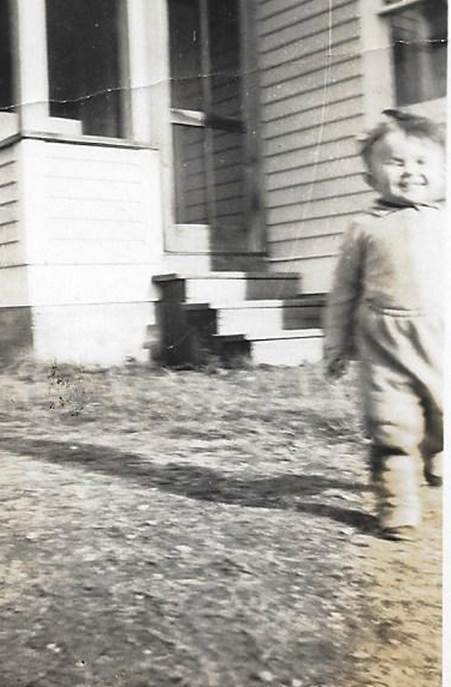
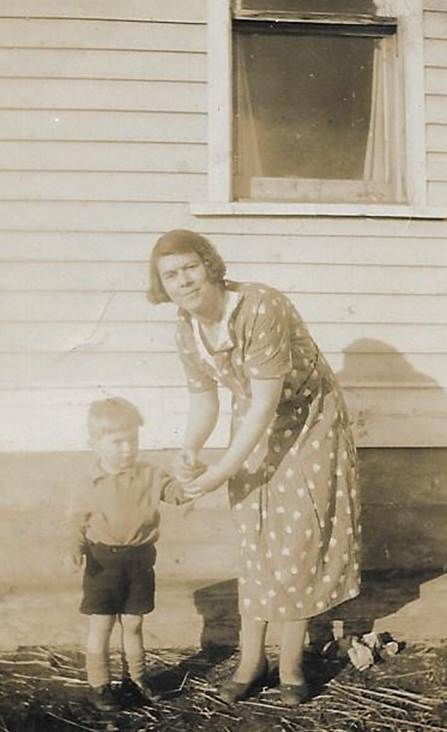
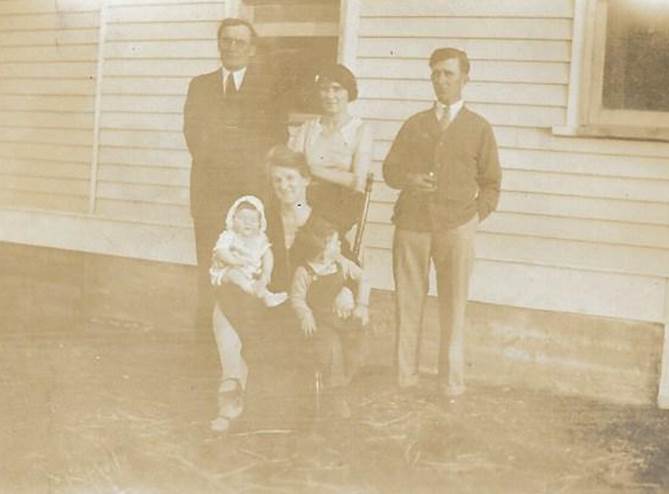

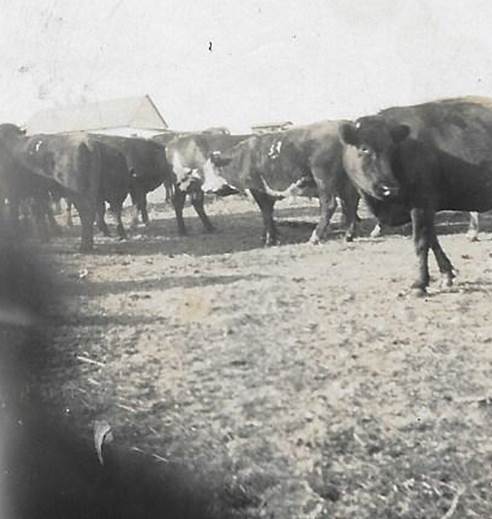

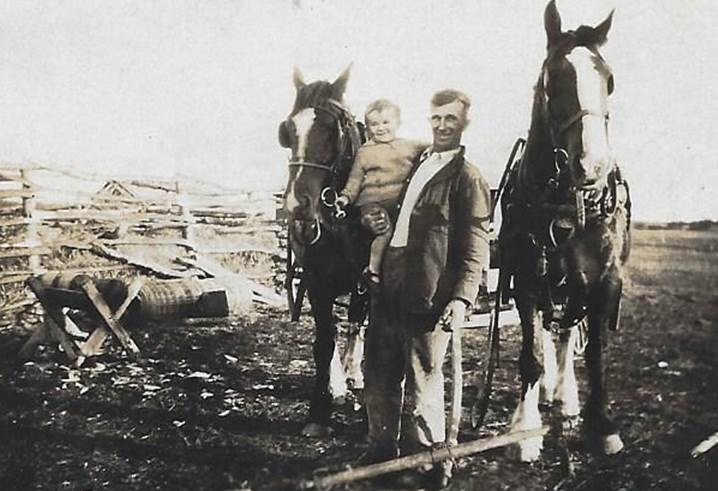
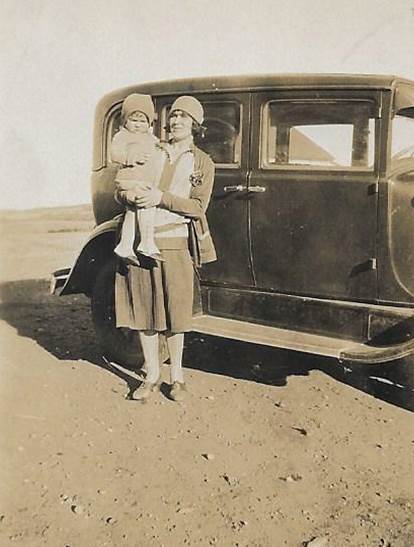


Life on the Prairie


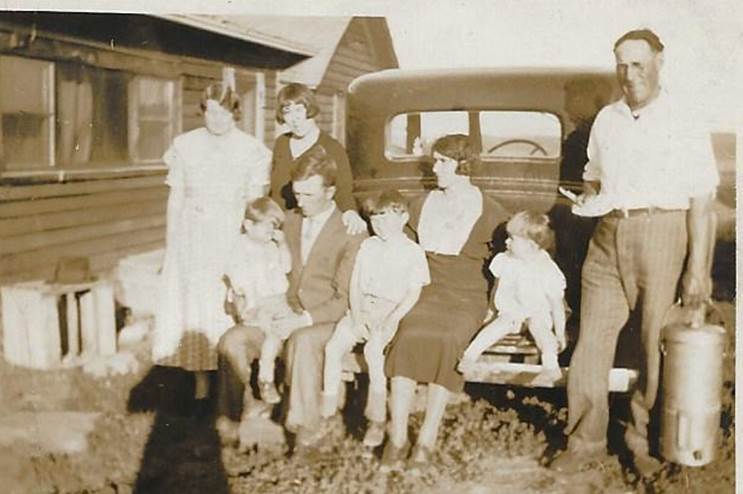

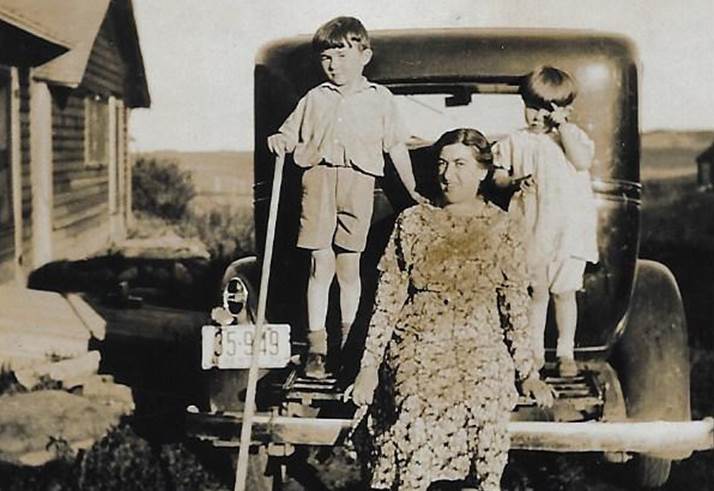

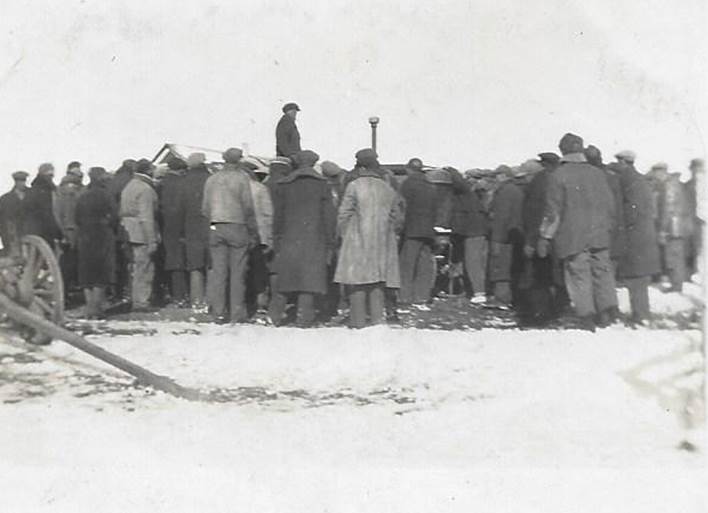


Shooting Party and
The Kinseys and Farndales in about 1931 – Back Row: Martin Farndale,
George Farndale, Ruth Farndale, Will Kinsey, Alfred Farndale, Jim
Farndale, Middle Row: Alfred Kinsey, Edna Farndale, Jimmy Farndale,
Martin Farndale, Grace Farndale, Dorothy Kinsey, Janie
Farndale, (Mary Farndale, Anne Farndale)


The Canadian Farndales at the Kinseys in about 1931, Martin, Jim, Kate,
Grace, George, Alfred At the Kinseys in about
1933, Back: Alfred Kinsey, Middle: Alfred Farndale, Dorothy Kinsey,
Peggy Farndale (with Anne Farndale), Grace Holmes, Martin Farndale, Bill Kinsey
Front: Kate Farndale, Howard Holmes
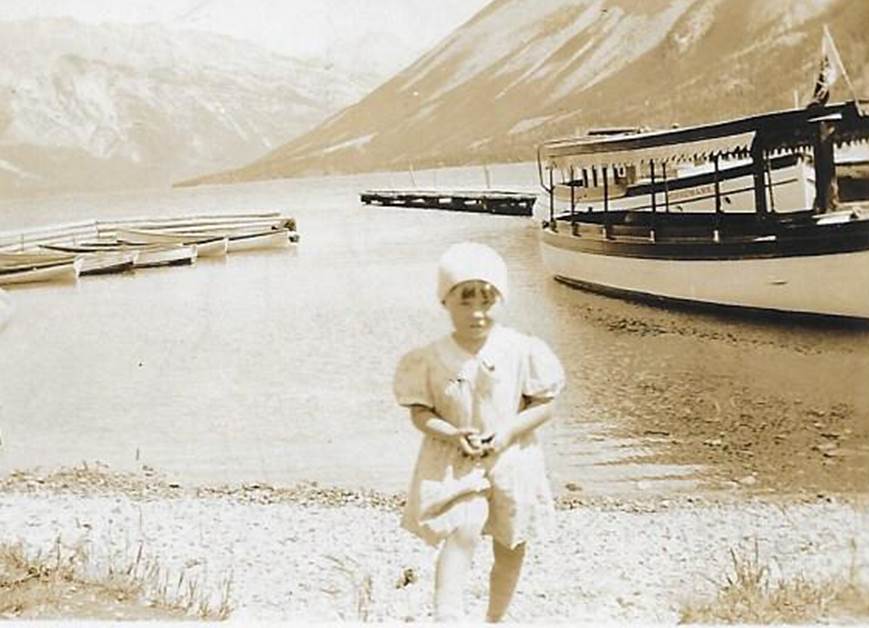


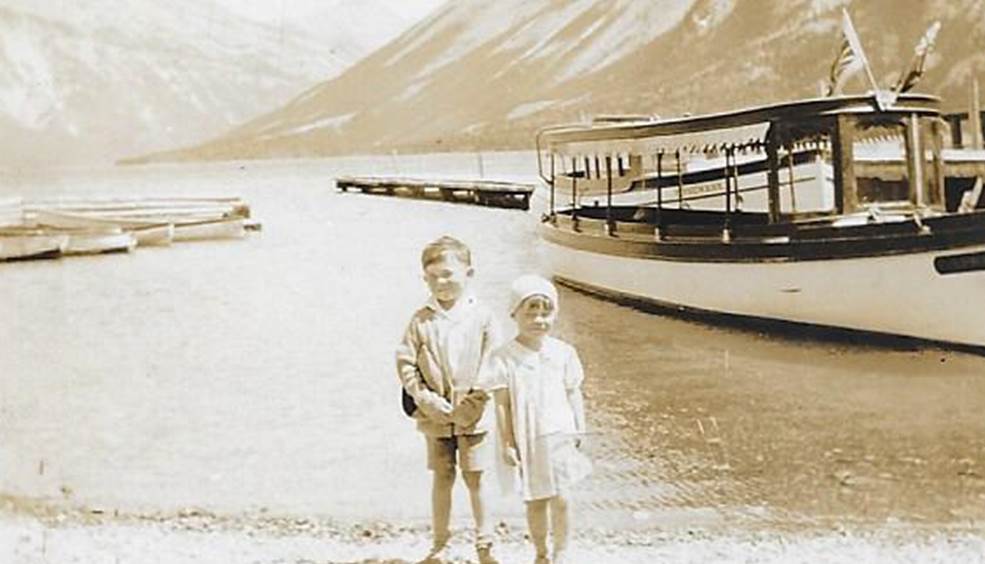
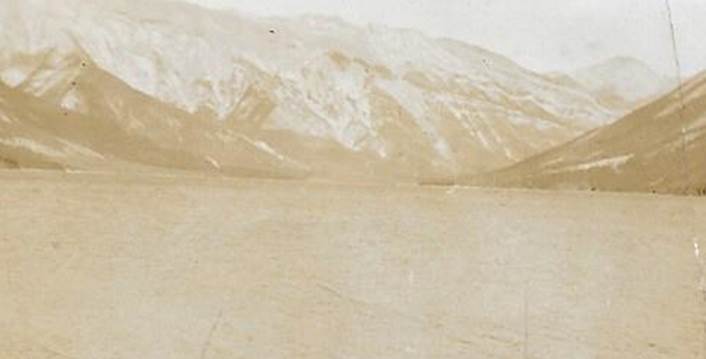




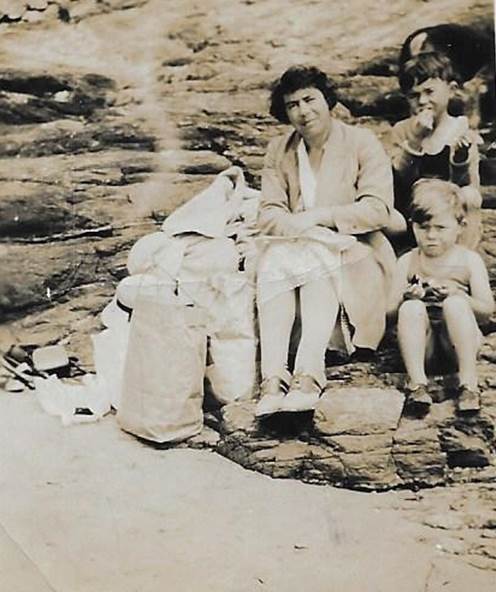
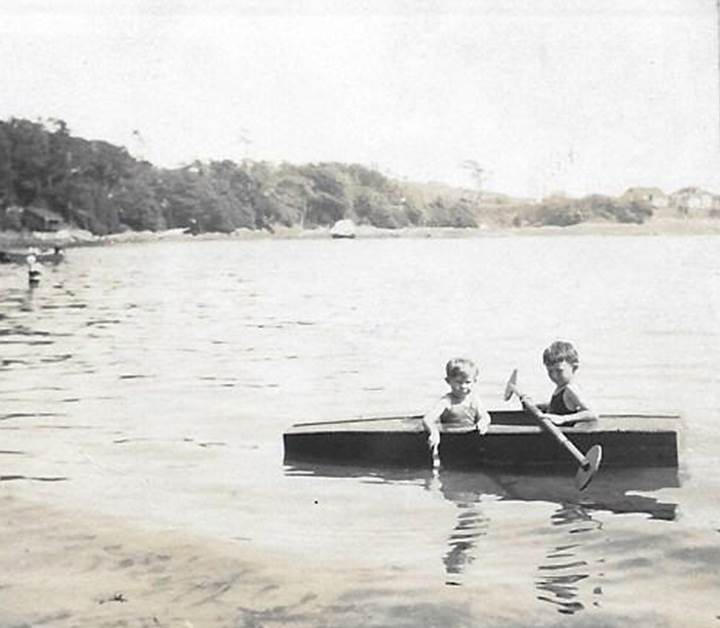
More holiday photos
Taken in Victoria, British Columbia
The Dominion Franchise Act, List of Electors, 1935 for the
Electoral District of Red Deer, Rural Polling
Division No 49, Huxley, comprising township 34, range 23, west of the 4th
meridian included a list for 35 Farndale, Alfred, farmer, Huxley and Farndale,
Mrs Alfred (W), Huxley.
But the early thirties were hard on the Prairie. It was hard to
get a crop at all, and when they did, the price was poor, often hardly paying
the elevator dues. The work was nearly all done by horses, but Allred bought
one of the first tractors in 1930.
During the long hot
summers, Peggy often took the family to the mountains at Banff, and to the
coast at Vancouver, and Victoria. Otherwise life consisted of hard work and
self made entertainment. Bridge parties were common in winter and picnics in
summer, with expeditions to the newly started Stampede in Calgary, or fishing
at Sylvan Lake. In winter life depended on the horse, either to ride or in a
sleigh. The 'rack' bodies were taken off their wheels and put onto runners to
get hay to the cattle. Meat was buried in the frozen ground to keep, but the
houses were always warm. On one occasion Alfred's dog ripped its tongue out by
licking the frozen railway line near Huxley, to which it had stuck, so intense
was the cold. He had to be shot. The call of the coyote was constantly heard
and returning late one evening skunk in the chicken house, which on being shot
left a pungent smell for a long time.
Looking back on
those days the family later remembered John Hibbs, the postman, driving his
buggy up to the farms from Huxley whistling and singing at the top of his
voice. Other neighbours well remembered, were Jake Miller, who farmed to the
east, Wagstaffsrds, and Billy Morris. On Huxley road were the
Thongs. the Shorts, by the slough; then the Delaneys. Huxley was a flourishing
little community in those days, with Roach's store and Miss Hibb's
confectionary store. There was Mr McMillan garage and even a Chinese
restaurant! There were perhaps a couple of hundred people in all. The grain
elevator played its vital part in prairie life, and still marked the little
township from many miles away in the 1980s.
There were many excitements; hail storms, dust storms and the snow. The heat,
the mosquitoes, the fresh prairie air, the stillness, blue skies, bright stars
at night, brilliant sunrises, and sunsets, and always in the distance the
rockies often covered in snow even in summer. The startling cloud formations
and the sudden thaw with the arrival of the Chinook wind. Indians travelling
round to cut the brush; Sergeant Hammond of the Royal Canadian Mounted Police,
and the stories of the Mad Trapper. On one occasion, young Martin aged 4 or 5,
was lost on the prairie, causing great concern and a massive search for the
corn was high and he was small and the danger great. But finally he was picked
up, having walked almost all the way to Huxley, by one of the MacMillans.
The gophers and the jack rabbits were everywhere and the countryside was brown
with the plough in spring, and yellow with wheat as far as the eye could see in
Summer. These are the sights and memories which, once experienced, can never be
forgotten.
But the years of crop failure and poor prices took their toll. The money ran
out and Alfred was forced to return to England with his family in 1935. Sadly
came the farm sale in March, and the family went to spend the last days in
Alberta with Grace and Howard Holmes at their ranch near Huxley. It was well
below zero on 8th April 1935 when they caught the train to Edmonton where they
began the five day journey to Halifax to catch the Duchess of Atholl for
Liverpool.
Martin Farndale later recalled But things were not well on
the farm. Prices were bad in the slump years of the early 30s and the weather
was unkind so that my father, along with many others, soon lost all his
savings, and in 1935, he decided to return to England. I remember well the excitement
of the farm sale by our white house with a black roof, on the hill overlooking
Huxley. It was early April and it was cold with snow still on the ground. We
spent our last few days in Alberta with Aunt Grace and Uncle Howard at their
Ranch near Huxley and finally caught the train at Huxley for Edmonton on 9
April 1935.


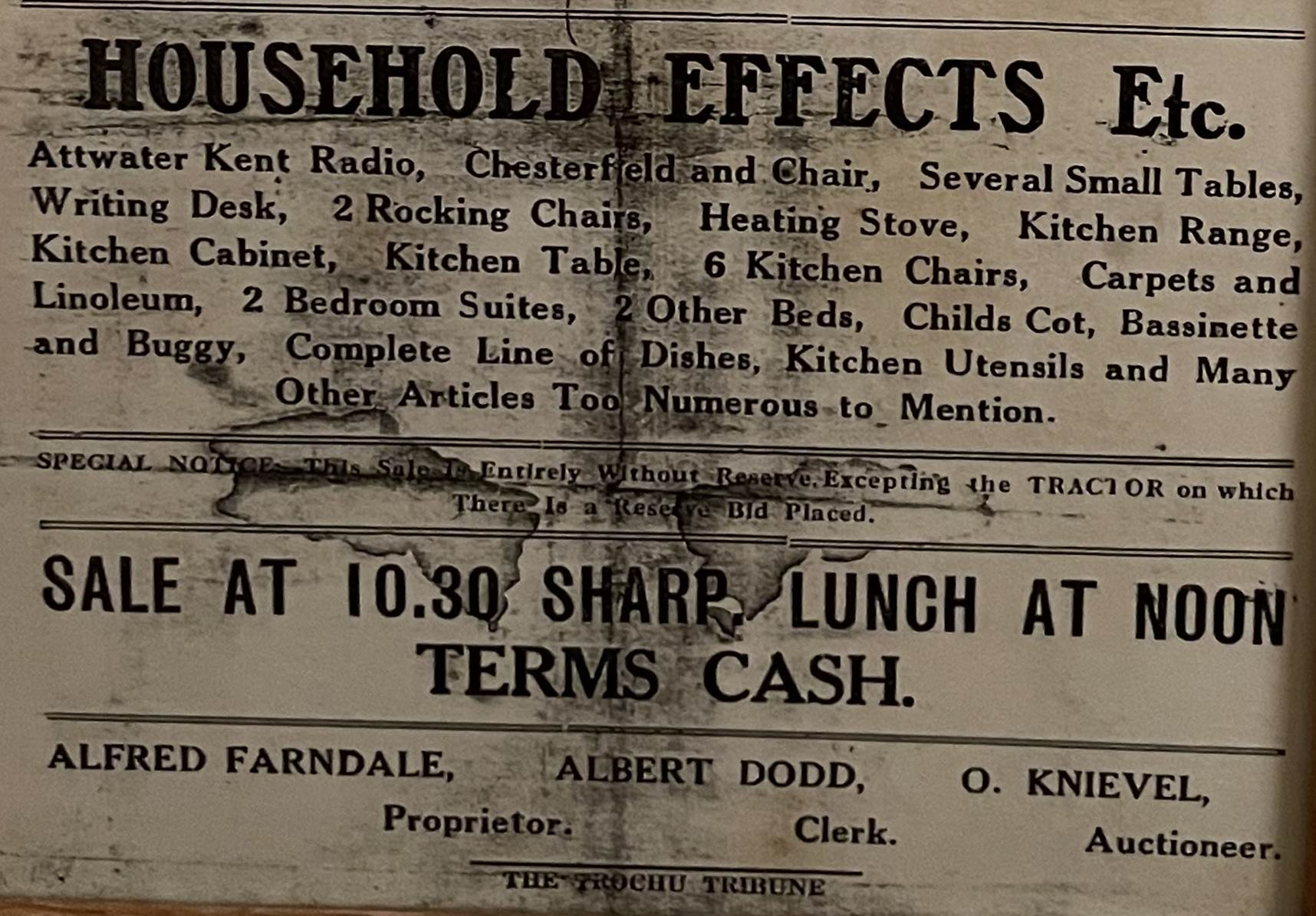
1935

Thornton le Moor and Northallerton
1935 to 1939
In a talk between Alfred Farndale and his son, Martin on 29
July 1982, Alfred recalled: We had a farm in
Middleton-One-Row in 1936 and then we moved to Sycamore Lodge at
Thornton-le-Moor near Northallerton in 1937. That was where
Margot was born. It was too small though and we left it in 1940 after the war
had started. We then lived at 117 Crosby Road, Northallerton. I was a farm
contractor doing ploughing and threshing. It was very hard work and very long
hours. I was Special Constable as well. Then, in January 1943, we
moved to Gale Bank Farm at Wensley. We had been looking for farms for years and this was easily
the best, so our luck had changed. It was then about 400 acres, but now it is
more. Peggy and I retired in 1972 and we are now living at
"Highfields", Eller Close Road, Leyburn."
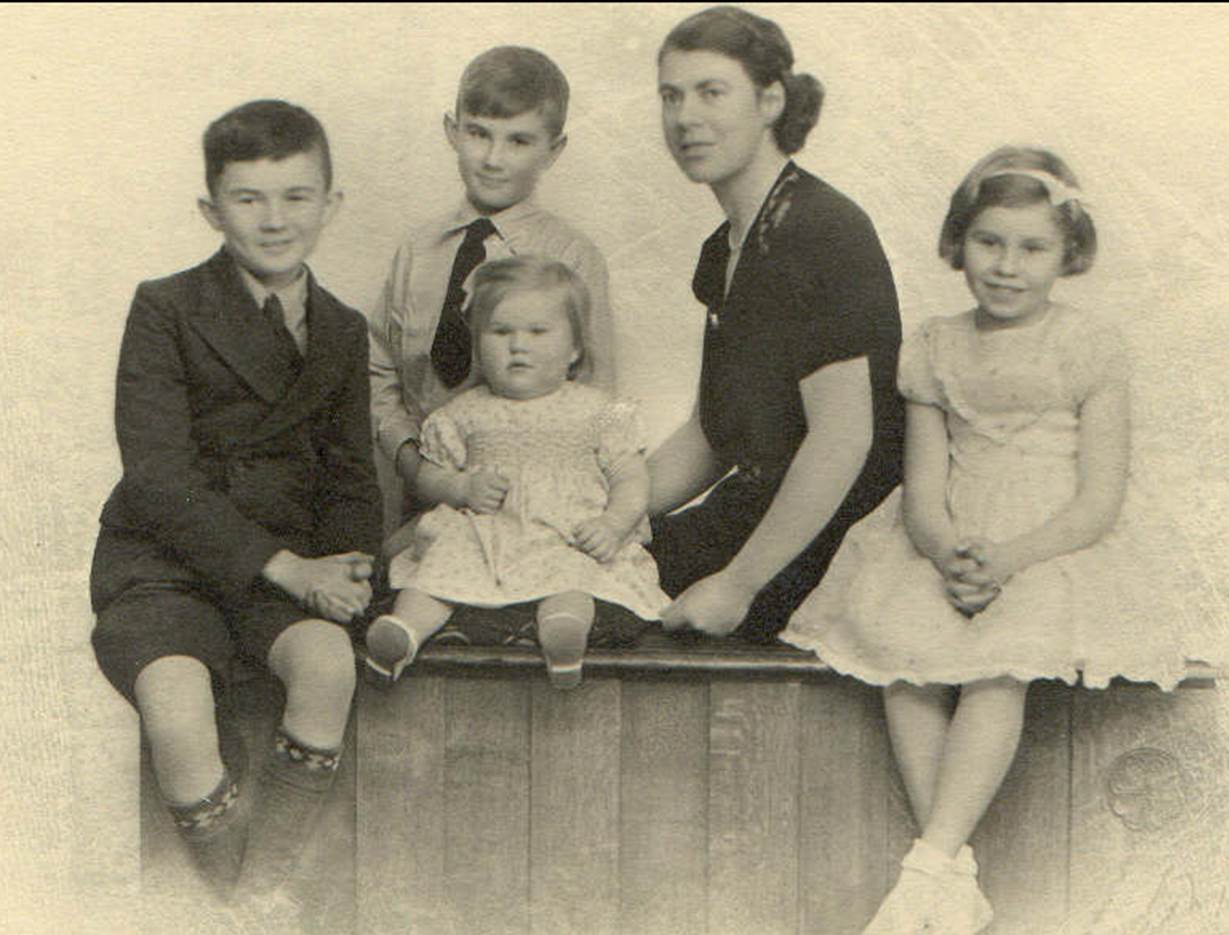
Alfred’s family in the late thirties: Martin, Geoff, Margot (front), Peggy
and Anne.
Martin later recalled My
parents both worked very hard and times were not easy. My mother looked after
us wonderfully well and set very high standards. She taught us all how to
behave, how to talk, to dress and conduct ourselves in company.
My father was working
very hard indeed at this time. It was hard physical graft and very long hours,
but there was plenty of work as farmers grew all they could. Sometimes I went
with him and I learnt how to plough on his Massy-Harris tractor. We once ploughed
in one of the fields from our old farm at Thornton-Le-Moor where I remembered
doing some ploughing with a pair of horses some year before. Frequently on
Thursdays I would cycle out to an agreed point and await my father with his
threshing crew to bring the men their wages.
But all this time my father was trying to get another farm. He went to
many, was short listed for some, and turned others down. I went to some with
him at weekends and I remember sharing is hopes and disappointments. It was a
difficult but exhilarating time. There was not much money, and a lot of hard
work. We had always had a car at this time. We had a 1937 Morris 12 which, in
1942, my father exchanged for a Standard 12 which he got from our doctor,
Doctor Milne.
1939
In the 1939 Register, Alfred Farndale, born 5 July 1897, a
farmer (mixed) lived at Sycamore Lodge, Thirsk with his wife, Margaret Louisa
Farndale, born 24 February 1901; Martin, Ann, Geoff and Margot records not yet
open; and Lerna E Gerrard (later married Hutchinson), single, born 6 February
1918, paid domestic duties.
In
World War 2 Alfred Farndale served as a Special Constable throughout the Second World War and was awarded the Police
War Medal.
1940

Alfred in 1940
1943
After Alfred farmed first
at Middleton-One-Row, near Darlington,
then at Thornton-le-Moor until 1940, the family moved to Northallerton until
1943 when they took Gale Bank Farm,
Wensley.
Gale
Bank Farm, Wensley, Wensleydale
We
moved to Gale Bank on 28 January 1943. I remember it all
very well. The furniture van came and everything was packed up. The rest of us
went in our heavily overloaded Standard 12. I remember it over heating just
outside Bedale and my father going into a farm and helping himself to a bucket of
water! I remember our arrival well, the house, and the buildings were quite
empty and we children raced throughout the empty house. There were strange
smells everywhere, particularly that of smoked bacon, which our predecessors
had done for years. We raced through all the farm buildings which were big and
extensive compared to anything we had known before. It must have been cold in
January and apart from a fire in the drawing room and kitchen in daytime only
there was o heat. But I don’t remember it being cold. With great excitement e
all chose our bedrooms and then the furniture van arrived and we all helped
move our things into the house. The beds were made – the same ones we had got
out of that morning in Crosby Road, and we were ready for bed in our new house.
Little did we know what a major step in our lives this day was to be for us
all. Gale Bank was to become our home, and a firm base for us all, for many
years to come.
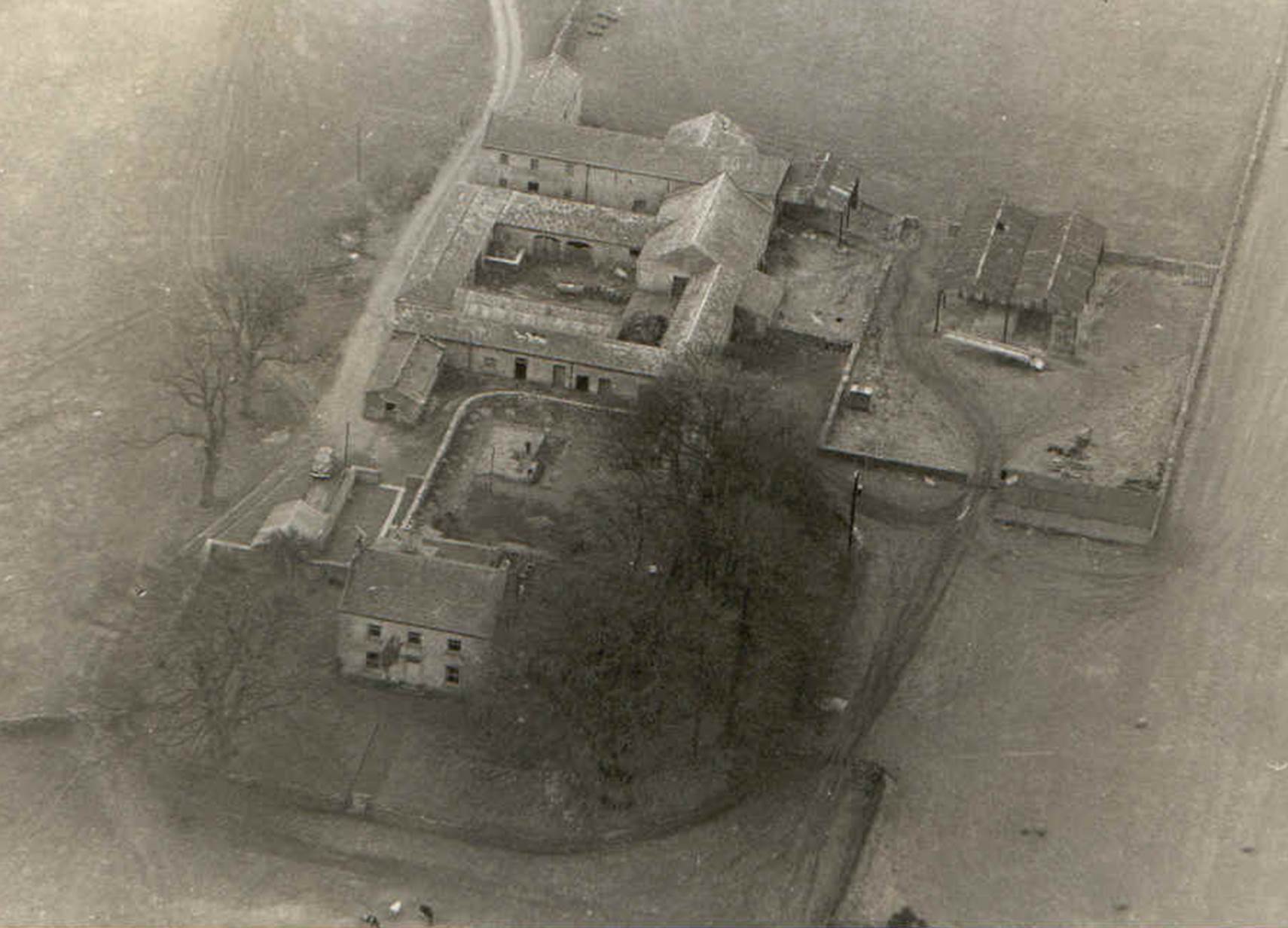
Gale Bank Farm
World War 2 came and went and in 1946 their son Martin joined
the British Army. He served in Egypt, Malaya, South Arabia and Ireland and was
involved in stopping the war in Rhodesia (Zimbabwe). In 1955 he married
Margaret Anne Buckingham and had a son, Richard. Sister Anne married Norman
Shepherd who worked for the BBC in Glasgow. They had two sons and a daughter,
Stephen, David and Catherine. Geoffrey continued to run the family farm in
Wensleydale with daughter, Christine, and son. Nigel. In 1937, Alfred and Peggy
had a second daughter, Margot, who married William Atkinson and they had a son,
William, and two daughters, Susan and Judith. (Our Huxley Heritage)
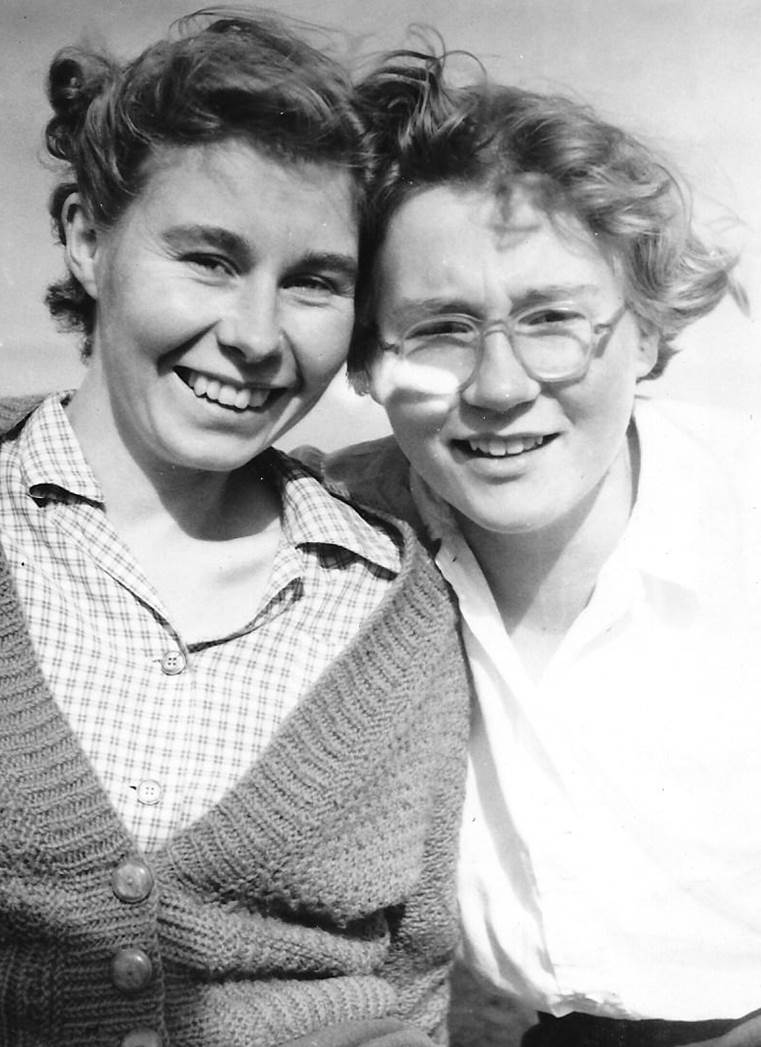
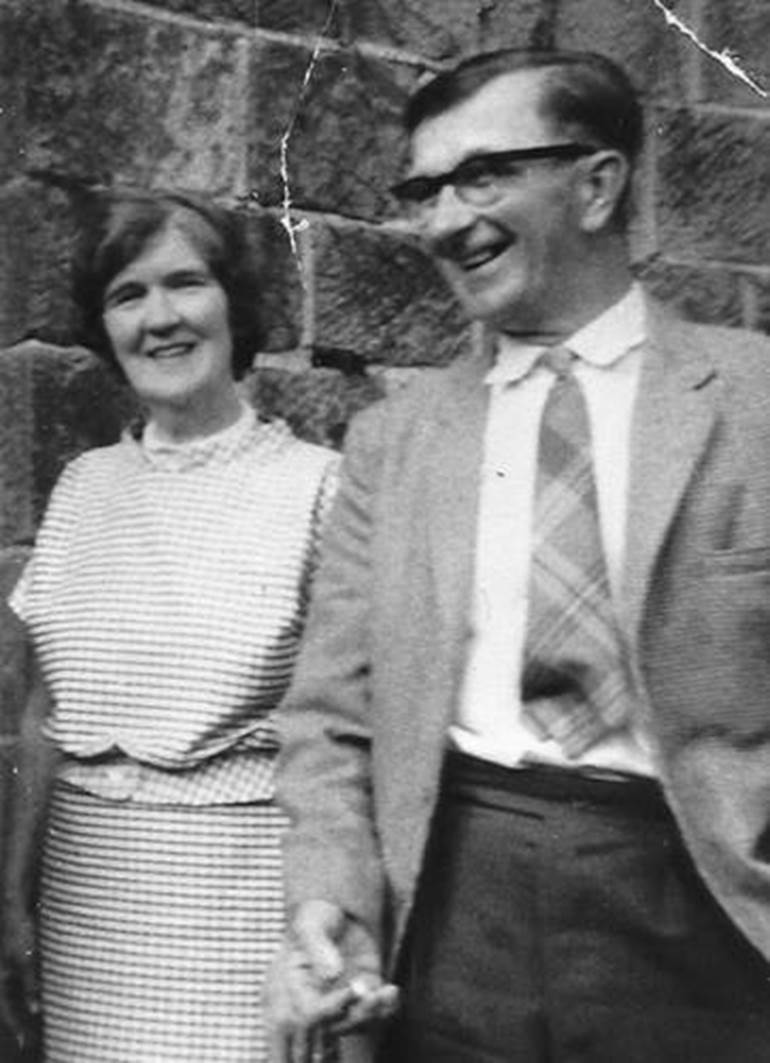

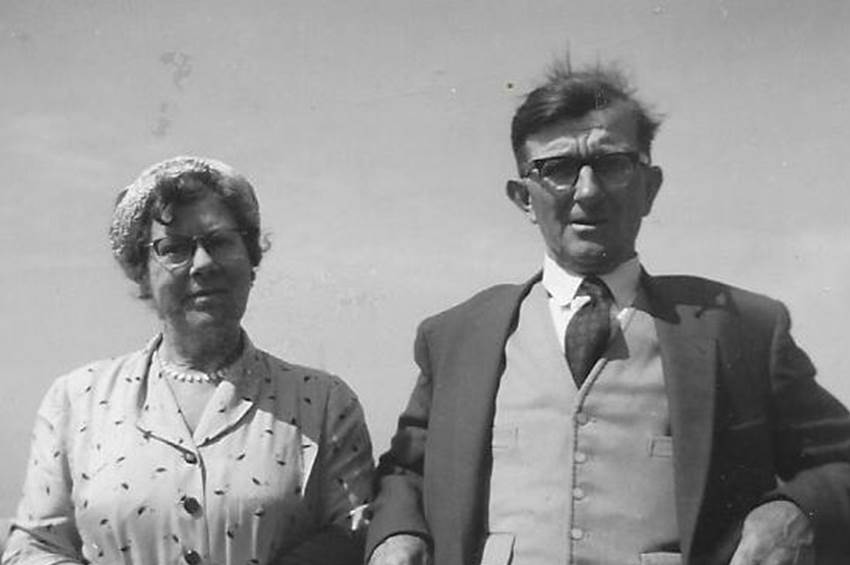
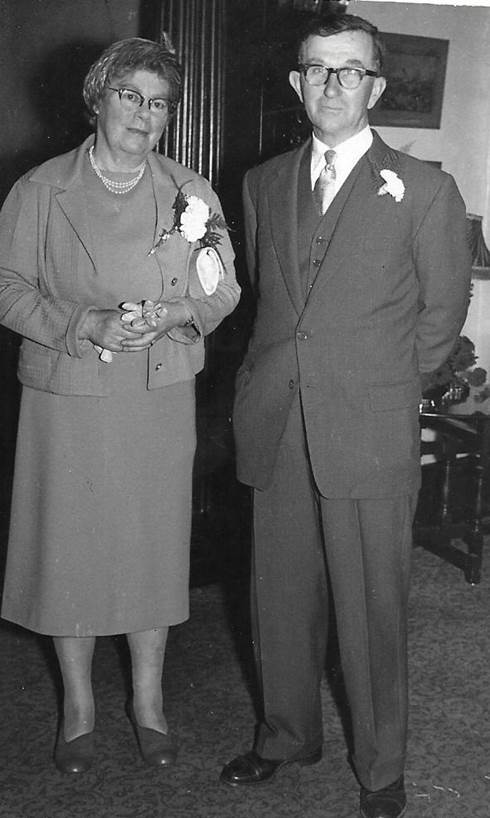
Alfred and Peggy travelled to Alberta again in 1958. The passenger list for those who landed at
Liverpool from Montreal on 29 September 1958 on the SS Empress of England,
included 337, Farndale, Alfred, M, 5.7,1897 and Farndale Margaret, F,
24./2/1901, both of Gale Bank Farm, Wensley, Near Leyburn, Yorks, Alfred a
farmer,
Leyburn,
Wensleydale
1971
Alfred
farmed at Gale Bank very successfully until they retired in 1971 to Leyburn and
lived at Highfields, named after the
famous family home of Peggy’s family, the Bakers, on Eller Close Road, Leyburn.

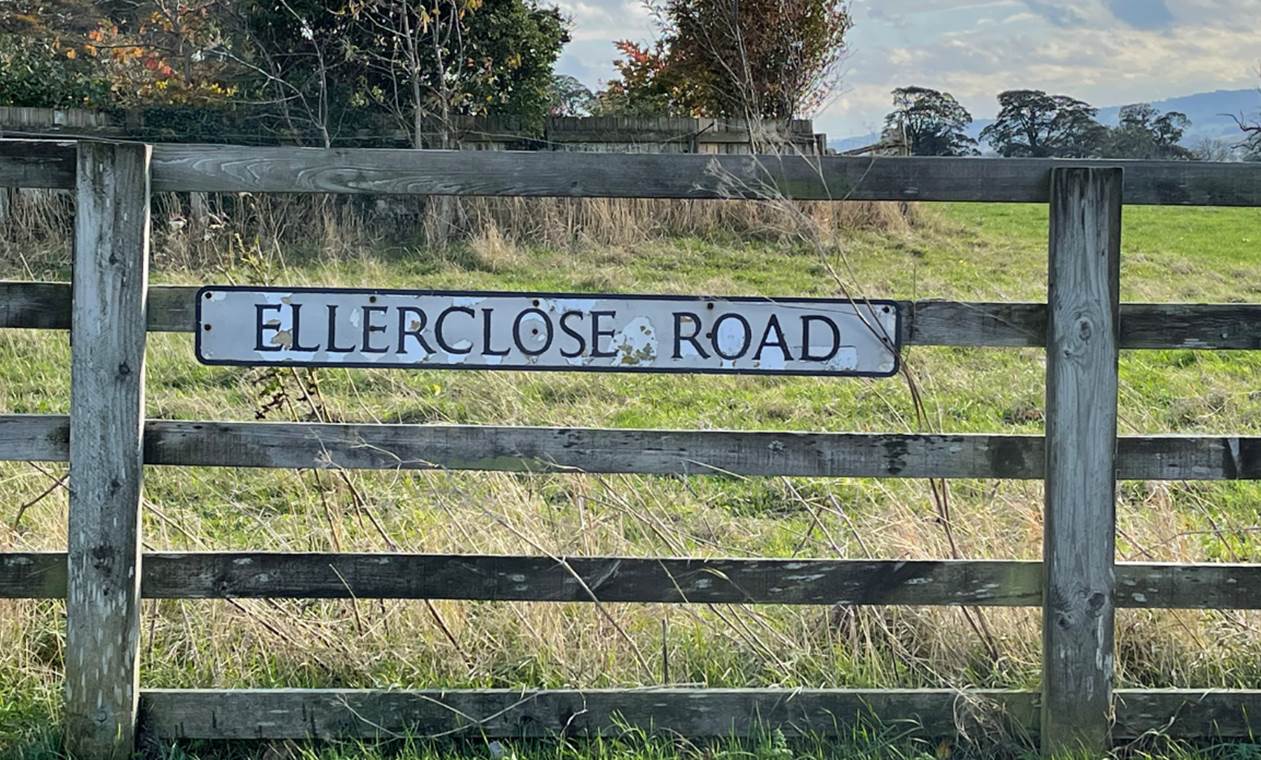

Highfields, Eller Clolse Road
1973
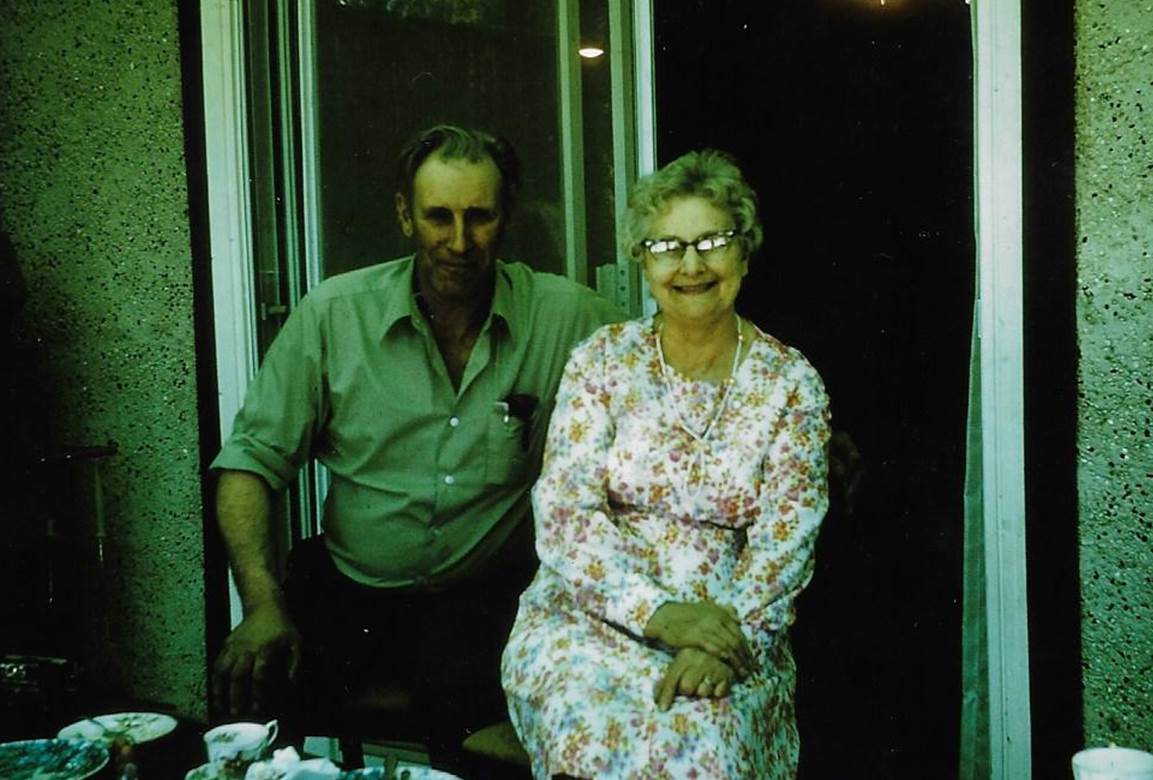
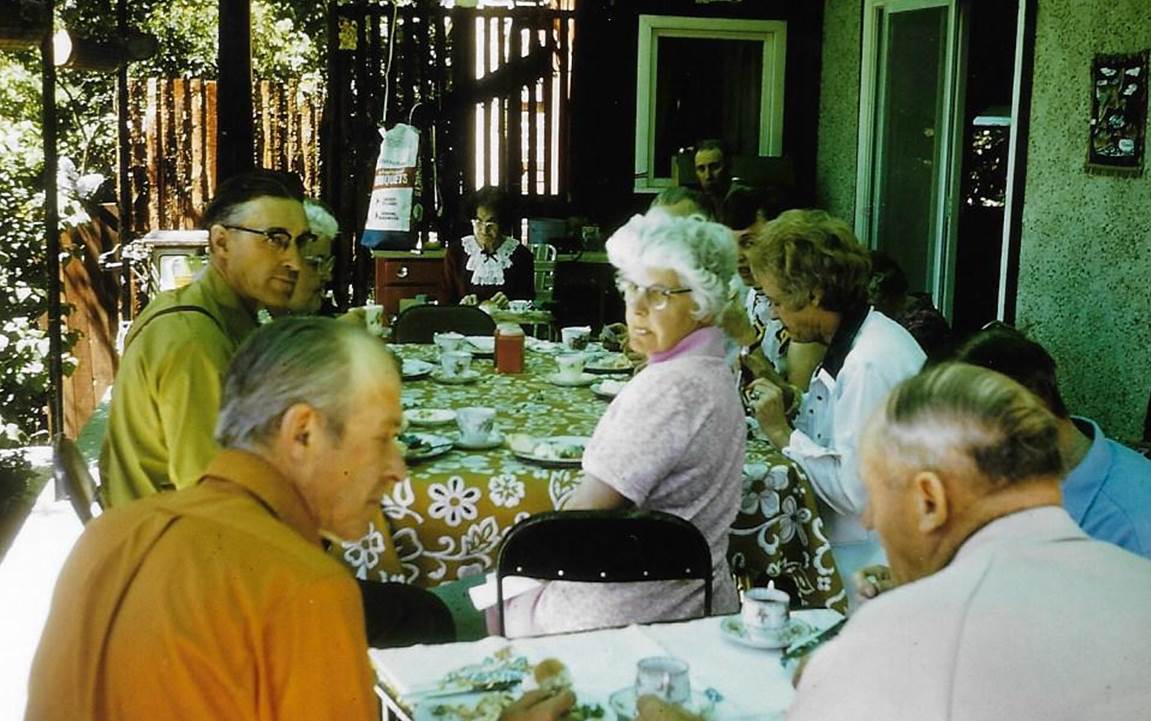
Aubrey and Glady Hogg who were the neighbours of the Farndales at Huxley,
during a visit by Martin Farndale in July 1973 Lunch at
the Hoggs in 1973
1970s and
1980s
Alfred was
then known by all his grandchildren as ‘Gran’ at Gale Bank Farm.




Gran feeding the
stock
The website author, Richard Farndale with Gramn by the River Ure Gran and the famous landrover
1978
Alfred and
Peggy had their Golden Wedding on 16 March 1978
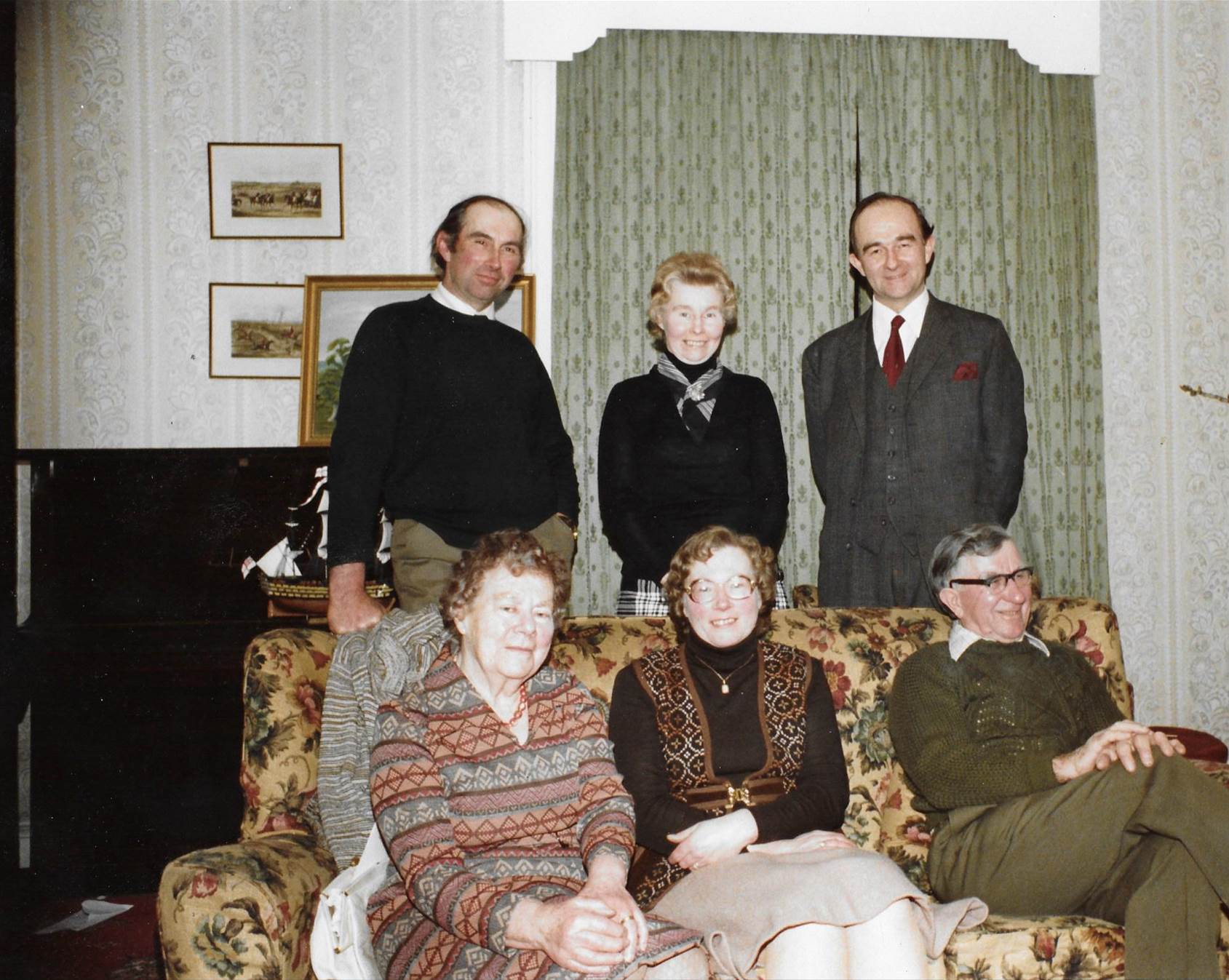
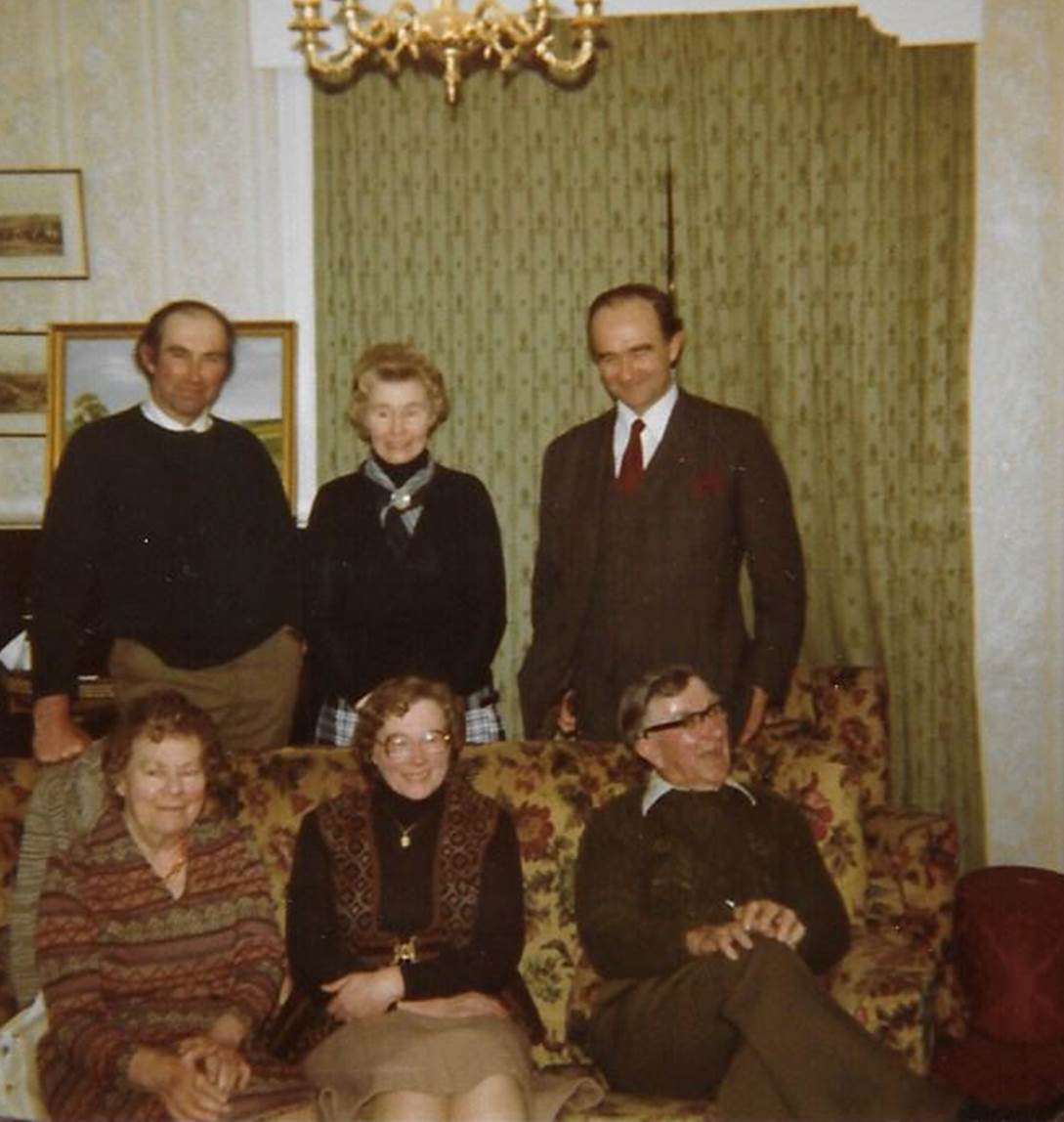
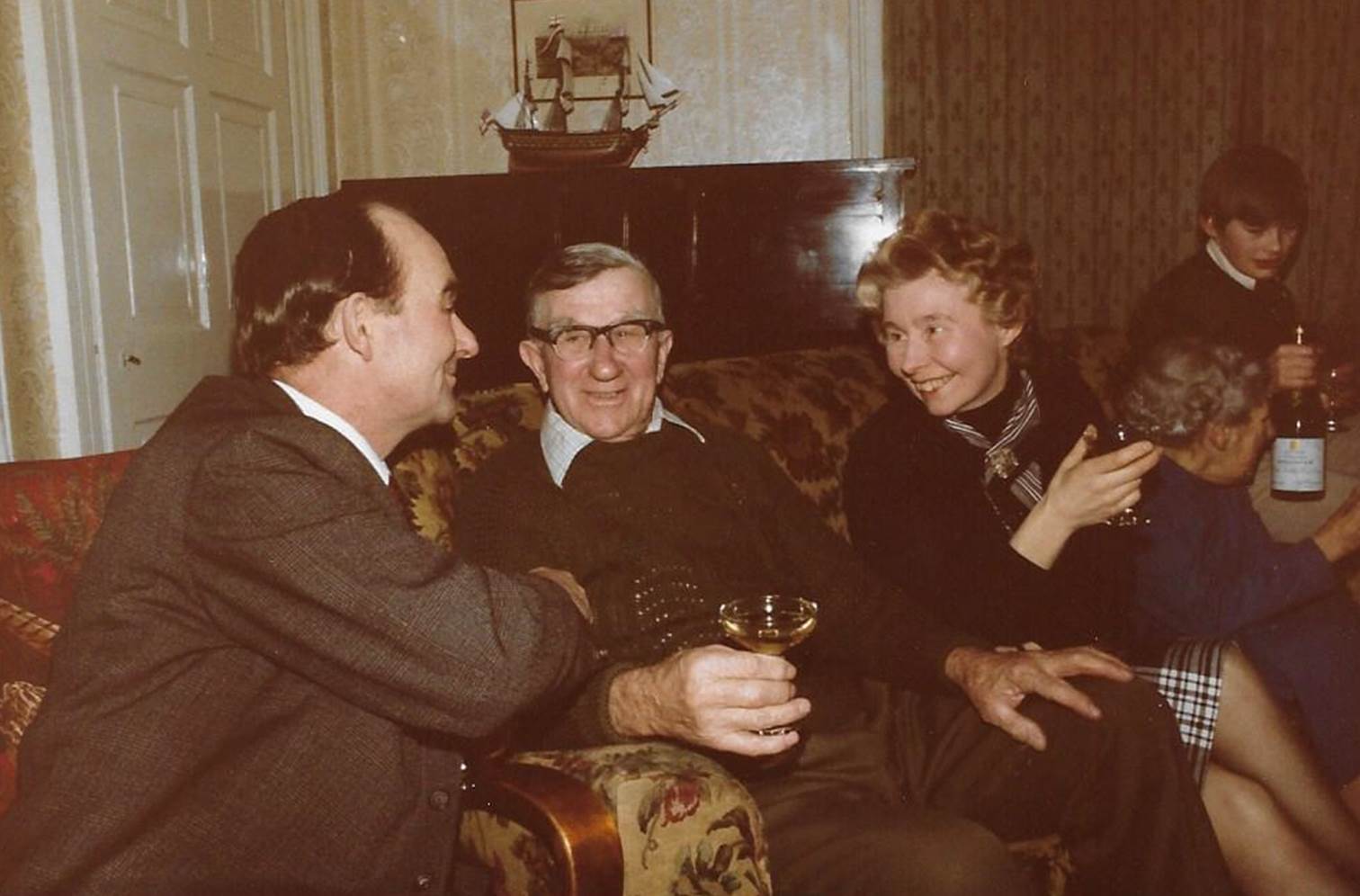
Back row: Geoff, Anne, Martin; Front Row: Peggy, Margot and Alfred
Martin jokes with Alfred and Anne


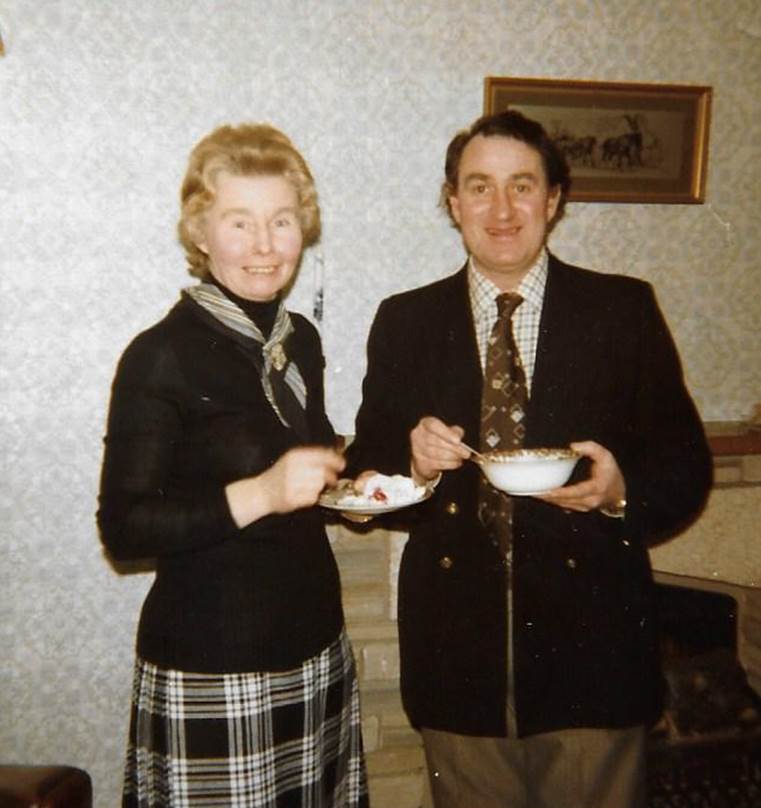
Peggy (Granny) amongst grandchildren
Grace with Stephen
Anne and husband Norman
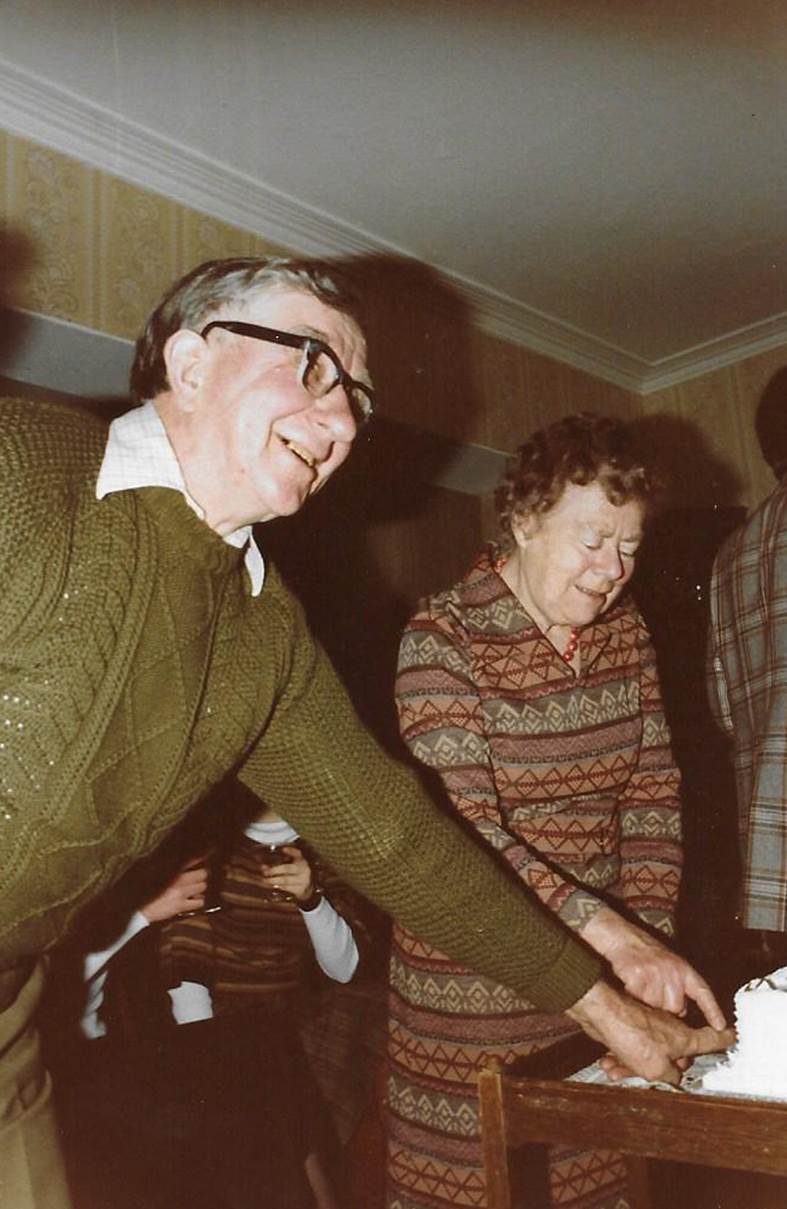
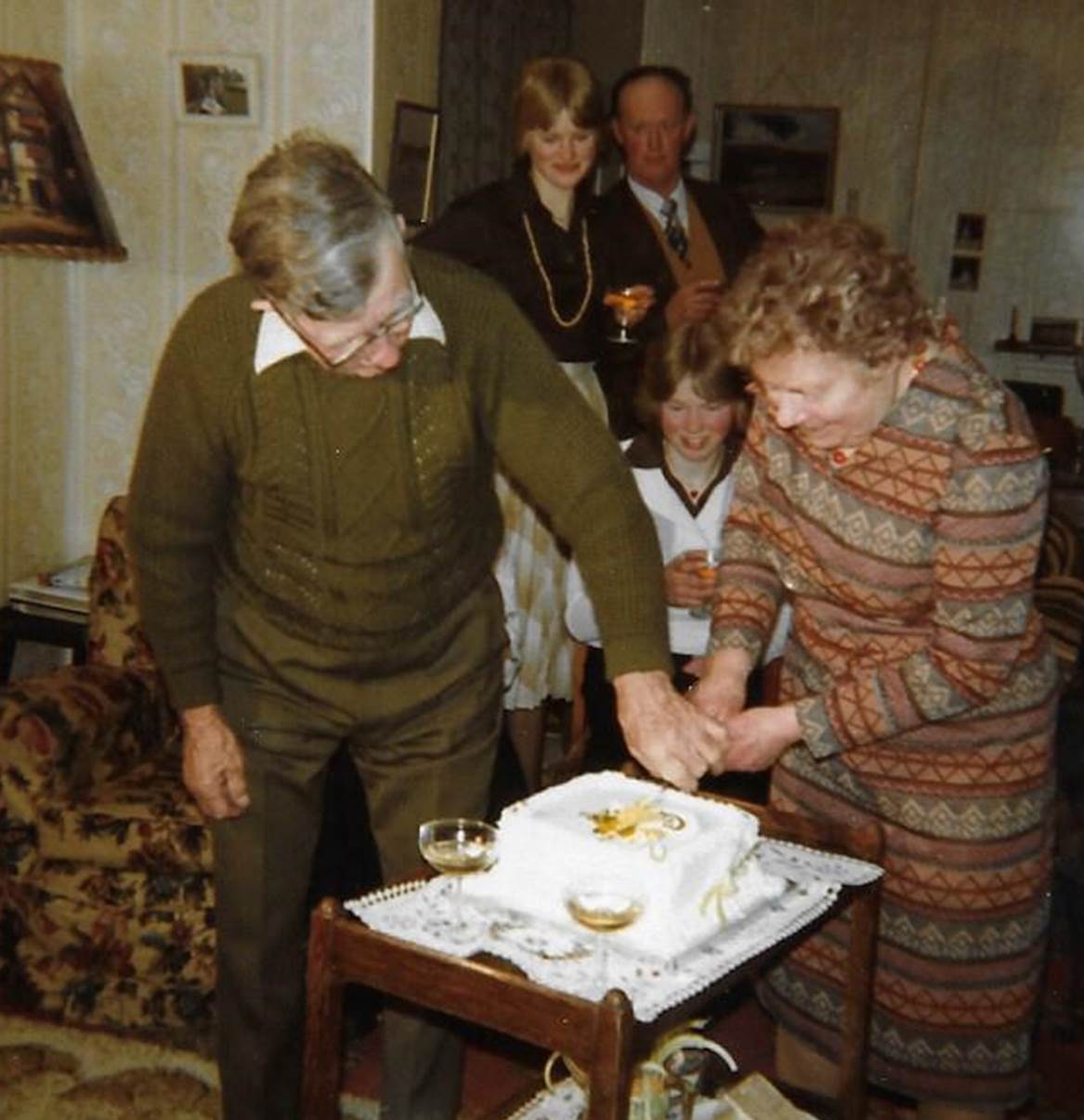

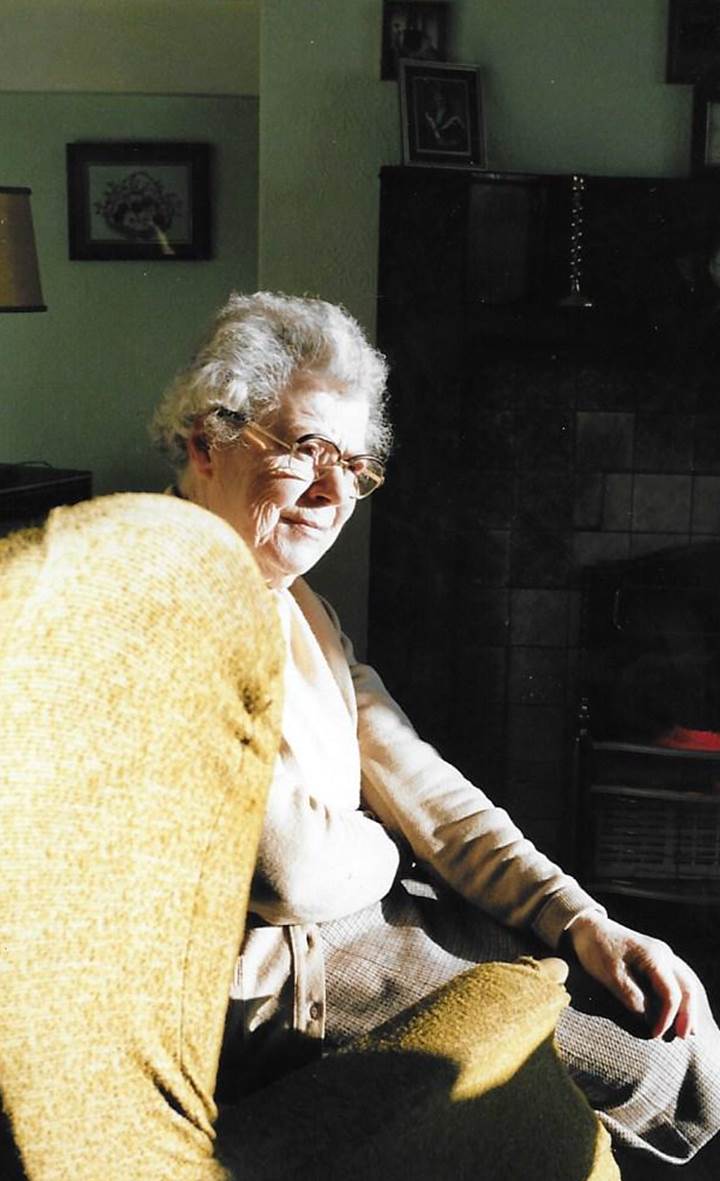

Gran under the tree at Gale Bank Farmhouse
Granny at Eller Close Road
Alfred’s wider family
in 1986
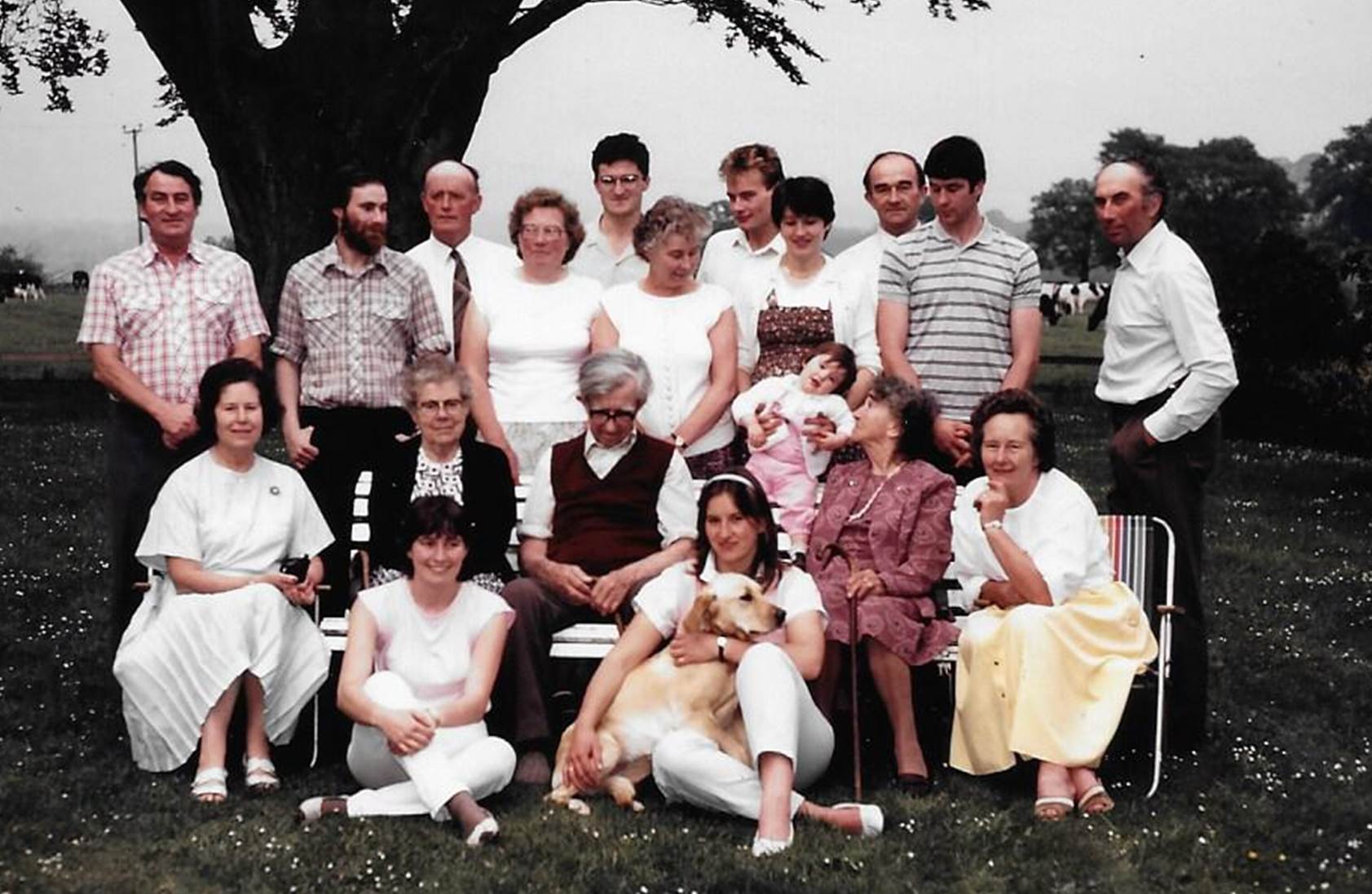

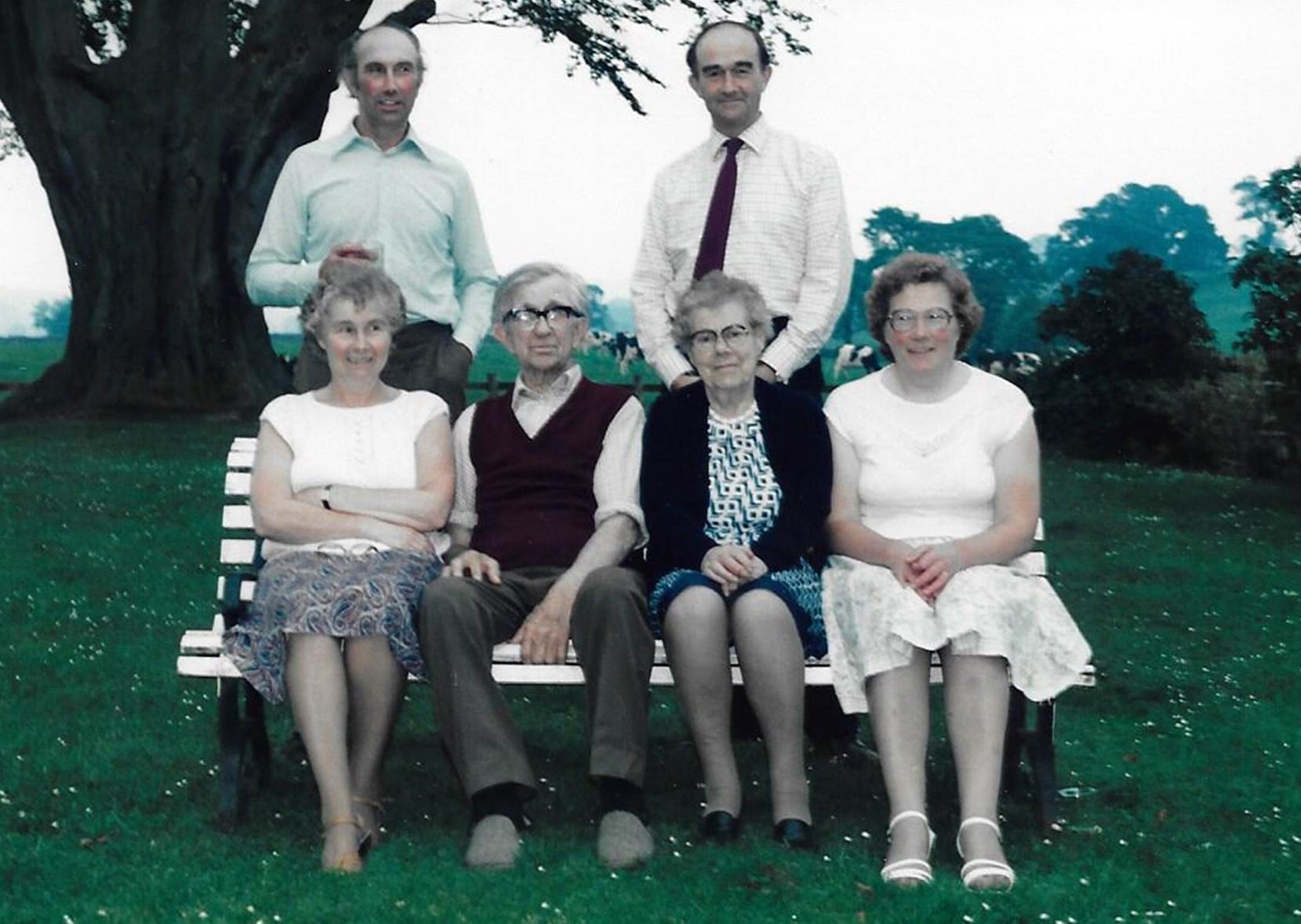

1987
Alfred Farndale,
died of prostate cancer, aged 89 years and 11 months on 30 May 1987 at Ruston
Hospital in Northallerton. He was cremated at Darlington and his
memorial stands in Wensley
Churchyard.
1996
Margaret Farndale died at Leyburn on 17th November
1996 age 95. She was cremated at Darlington and her Memorial is in Wensley Churchyard. (DR)
(Most of above from
family knowledge)
